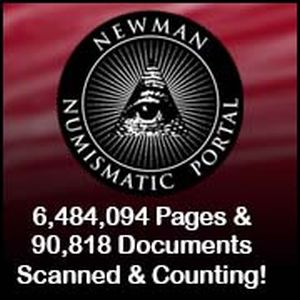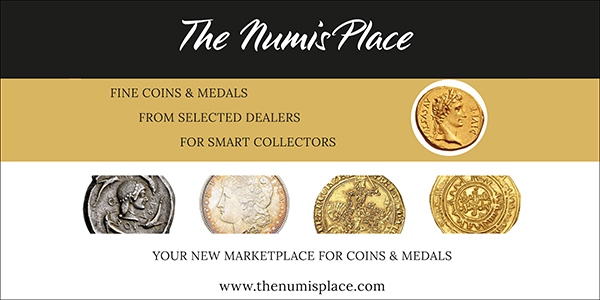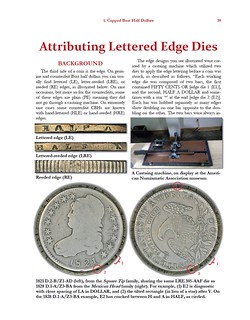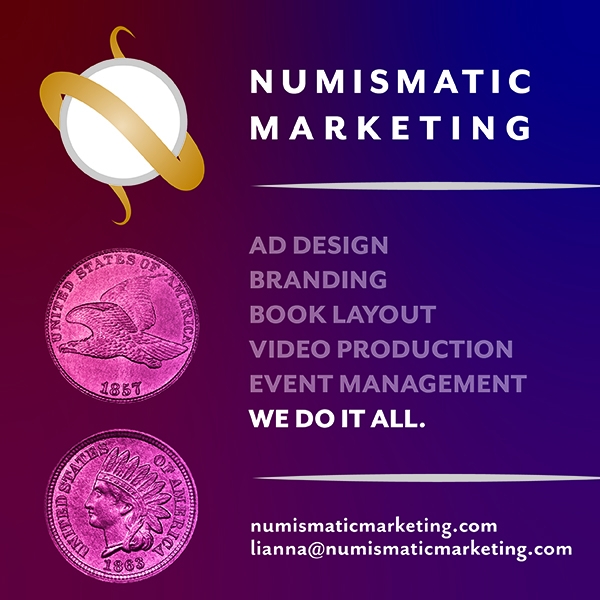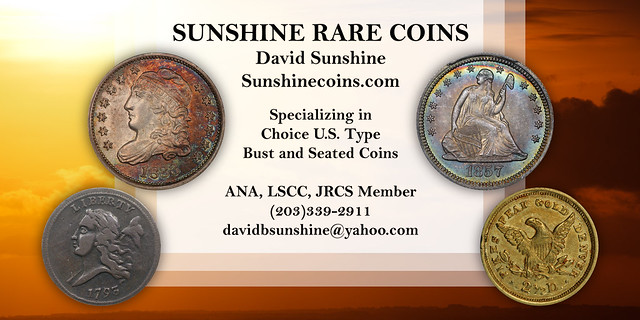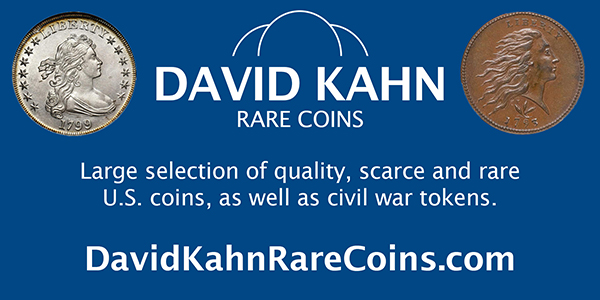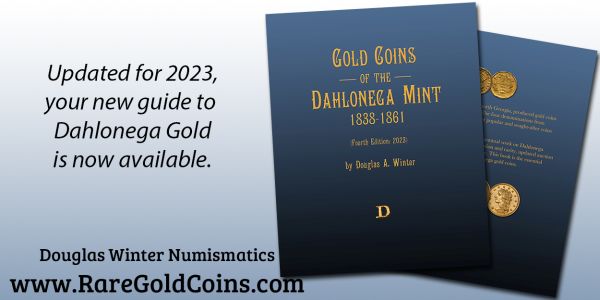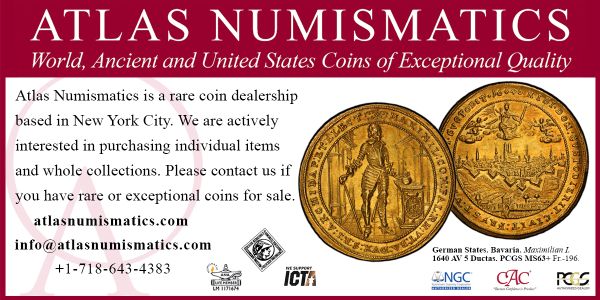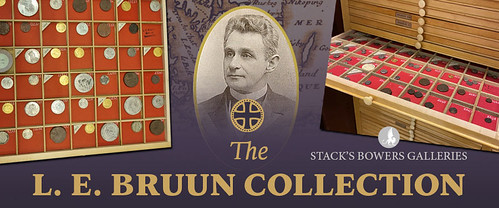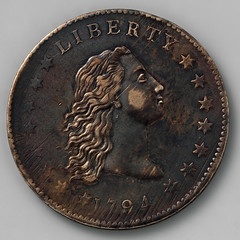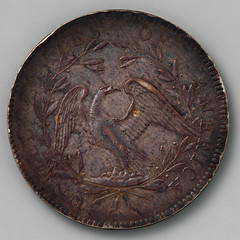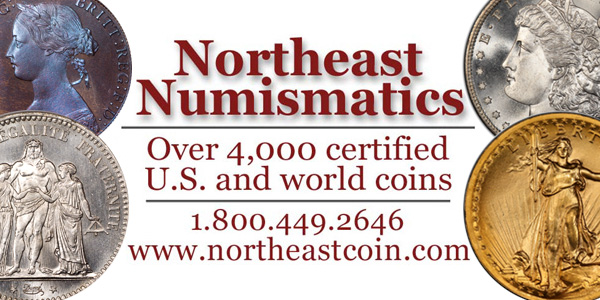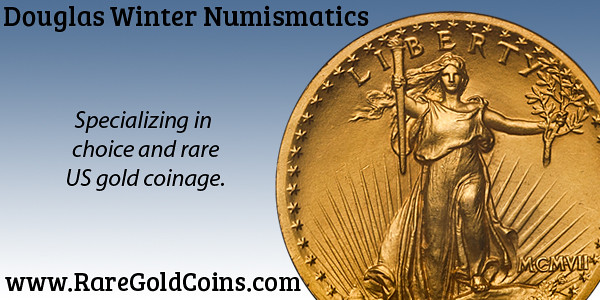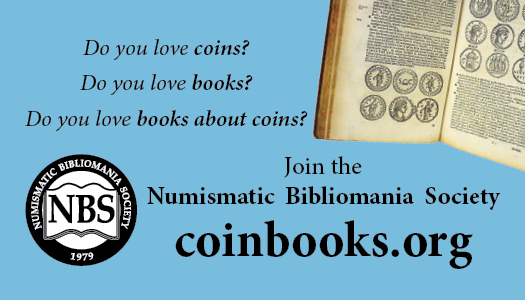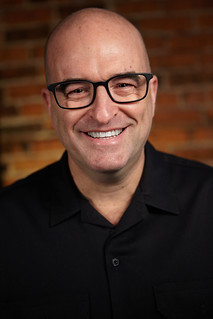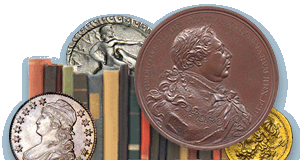
Visit our NBS Sponsors
About UsThe Numismatic Bibliomania Society is a non-profit association devoted to the study and enjoyment of numismatic literature. For more information please see our web site at coinbooks.org SubscriptionsThose wishing to become new E-Sylum subscribers (or wishing to Unsubscribe) can go to the following web page link MembershipThere is a membership application available on the web site Membership Application To join, print the application and return it with your check to the address printed on the application. Print/Digital membership is $40 to addresses in the U.S., and $60 elsewhere. A digital-only membership is available for $25. For those without web access, write to: Jeff Dickerson, Treasurer AsylumFor Asylum mailing address changes and other membership questions, contact Jeff at this email address: treasurer@coinbooks.org SubmissionsTo submit items for publication in The E-Sylum, write to the Editor at this address: whomren@gmail.com BUY THE BOOK BEFORE THE COINSale Calendar
|
- WAYNE'S WORDS: THE E-SYLUM MAY 25, 2025
- ASYLUM SUMMER 2025 ISSUE PUBLISHED
- MORE KOLBE & FANNING SALE 173 HIGHLIGHTS
- NEW BOOK: BAD METAL: SILVER 50C TO $1
- MARVIN LESSEN (1934-2025)
- DAVID L. GANZ (1951-2025)
- NEWMAN GRANTS 2025 AWARD ANNOUNCEMENT
- MEMORIAL DAY AND THE G.A.R.
- VIDEO: LOCAL CURRENCIES AND COINS
- NOTES FROM E-SYLUM READERS: MAY 25, 2025
- LOST MINT DOCUMENTS FOUND
- REWARD FOR STOLEN CONNECTICUT COPPER
- COPPERS OF GEORGE WASHINGTON'S AMERICA
- VOCABULARY TERM: REVERSE
- PATRICK W. BARNARD (1940-2017)
- NUMISMAGRAM MEDAL SELECTIONS: MAY 25, 2025
- NOONANS TO SELL BRITISH IRON AGE COIN HOARD
- NOONANS TO SELL RARE IRISH FREE STATE COIN
- STACK'S BOWERS: BRUUN COLLECTION CONTINUES
- GARRETT'S NUMISMATIC DIARY: THE NETHERLANDS
- WAYNE'S NUMISMATIC DIARY: MAY 25, 2025
- HEREFORDSHIRE HOARD COIN RECOVERED
- CASTLE ACQUIRES ANGLO-SAXON COIN HOARD
- PENNY PRODUCTION TO HALT
- SCRIP FOR DISPLACED GERMAN JEWS AFTER WWII
- LOOSE CHANGE: MAY 25, 2025
- LADY LIBERTY'S TREASURE
- ABOUT THIS ISSUE: MAY 25, 2025
Content presented in The E-Sylum is not necessarily researched or independently fact-checked, and views expressed do not necessarily represent those of the Numismatic Bibliomania Society.
WAYNE'S WORDS: THE E-SYLUM MAY 25, 2025
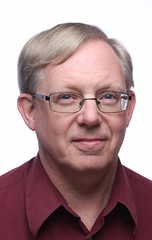 New subscribers this week include:
Carlos Kearns.
Welcome aboard! We now have 7,239 subscribers.
New subscribers this week include:
Carlos Kearns.
Welcome aboard! We now have 7,239 subscribers.
Thank you for reading The E-Sylum. If you enjoy it, please send me the email addresses of friends you think may enjoy it as well and I'll send them a subscription. Contact me at whomren@gmail.com anytime regarding your subscription, or questions, comments or suggestions about our content.
This week we open with a new Asylum issue, more Kolbe & Fanning sale selections, one new book. two obituaries, updates from the Newman Numismatic Portal, notes from readers, and more.
Other topics this week include circulating contemporary counterfeit coins, the 2025 Newman Grants, lost and found coins and documents, a stolen coin, fixed price and auction previews, a rare Irish Free State coin, two numismatic diaries, scrip for displaced Jews, and the end of the U.S. cent.
To learn more about Jacob Perkins' Bank Bill Test, NBS events at this year's ANA summer convention, the Matthew Stickney collection, Numismata Cromwelliana, the story of the Bicentennial coinage, U.S. Postal Notes, Rebecca Salisbury, the Grand Army of the Republic, Contamin's die cutting machine, the New Treasure Room, Lady Liberty's Treasure Hunt, and the Cowboy Coin Contest, read on. Have a great week, everyone!
Wayne Homren
Editor, The E-Sylum
ASYLUM SUMMER 2025 ISSUE PUBLISHED
The Summer 2025 issue of The Asylum is on the way from our sponsor, the Numismatic Bibliomania Society. -Editor
Welcome to The Asylum's Summer 2025 digital edition.
In this issue:
-
 NBS Board of Trustees 2025–2027 Slate of Candidates
NBS Board of Trustees 2025–2027 Slate of Candidates
- Early Attempts to Preserve U.S. Mint History By Roger W. Burdette
- A Census of Jacob Perkins' Bank Bill Test (1809) By Leonard Augsburger
- The Search for William Veach and His Gold Frog Riddle By Roger A. Moore
Message from NBS President Len Augsburger
Welcome to our spring issue, as always capably orchestrated by our editor, Maria Fanning. We are grateful for your article contributions, and the wide array of content demonstrates active interest in numismatic literature and research. While spending time with The Asylum and our numismatic libraries is always pleasant, there is no substitute for in-person interaction, and we hope to see many of you at the ANA convention this summer. I like to think there is something inherently human about face-face contact, and for this reason I have no fear that coin shows will disappear. Perhaps there will be consolidation or other evolution, but people like to get together and always have. While online connection is a useful supplement, in-person connection remains richer and more nuanced.
Although this year's ANA summer convention is not in the most accessible location (Oklahoma City), almost all the people I've communicated with expect to attend, albeit with a bit of grumbling about the site selection, mostly in proportion to their distance from the convention center. Be that as it may, we are planning on our usual NBS programming, including the NBS Symposium on Thursday (August 21) and the NBS General Meeting on Friday (August 22). The Symposium highlights recently published works, and, if you are so inclined to present, do contact me directly. The General Meeting will feature our annual Benefit Auction, which features a variety of numismatic literature. Please contact me or David Fanning (df@numislit.com) if you wish to donate material to this sale.
Enjoy this current issue of The Asylum, and we hope to see you at the ANA convention in August!
NBS Membership Renewal Time!
 Please renew your membership in the NBS to continue receiving The Asylum. Go to coinbooks.org to pay by PayPal or download a membership form today. Your current expiration date is printed to the right of your name on your subscription envelope, which should be arriving soon.
Please renew your membership in the NBS to continue receiving The Asylum. Go to coinbooks.org to pay by PayPal or download a membership form today. Your current expiration date is printed to the right of your name on your subscription envelope, which should be arriving soon.
MORE KOLBE & FANNING SALE 173 HIGHLIGHTS
Here's another set of highlights from the upcoming Kolbe & Fanning numismatic literature sale. -Garrett
 On Saturday, May 31, 2025, Kolbe & Fanning Numismatic Booksellers will be holding our next auction, Sale 173, featuring material from the library of Barry Tayman and the second half of the L.D. & I.P. Library. The sale includes rare and out-of-print works on ancient, world and U.S. numismatics, with the 500 lots offering something for everybody.
On Saturday, May 31, 2025, Kolbe & Fanning Numismatic Booksellers will be holding our next auction, Sale 173, featuring material from the library of Barry Tayman and the second half of the L.D. & I.P. Library. The sale includes rare and out-of-print works on ancient, world and U.S. numismatics, with the 500 lots offering something for everybody.
Some highlights of this first sale include:
Lot 3: a well-preserved original copy of the enormously important catalogue of the Dr. Samuel Pozzi collection, sold at auction by Naville/Ars Classica in 1921
Lot 70: a complete set of Charles Dupriez's La gazette numismatique, published in thirteen volumes between 1896 and 1913 and rarely encountered
Lot 25: the 1755 sale catalogue of the Dr. Richard Mead collection, conducted by Samuel Baker in London, arguably the first truly important numismatic auction held in England
Lot 97: Ernst Justus Haeberlin's monumental Aes Grave, including the enormous folio volume of 103 exceptionally fine plates of the early Italian cast coinage
Lot 236: a complete set of Warren Baker's very scarce early fixed price lists of Canadian coins, medals and tokens, published between 1966 and 1979, bound in two volumes
Lot 351: Colonel E.H.R. Green's copy of Henry Chapman's 1907 catalogue of the Matthew Stickney collection, with 20 fine photographic plates
Lot 407: Burdette G. Johnson's extensive invoice files for 1940–1947, comprising seven archival file boxes holding some 3000 invoices for tens of thousands of coins
Lot 322: one of only 16 deluxe copies of Medallic Portraits of Admiral Vernon, by John W. Adams, Fernando Chao and Anne Bentley, bound in tan half morocco
Lot 446: a bound volume from the Edgar H. Adams library including what is perhaps the finest extant copy of the rare 1892 George D. Woodside catalogue with plates.
Lot 442: an exceptional, finely bound complete set of the auction catalogues issued by the New Netherlands Coin Company, from the libraries of Craig N. Smith and John W. Adams
Review Bidder Information
When registering to bid, please review your contact and payment information, especially shipping address, to ensure that your lots are shipped quickly and correctly.
Register early to bid online
Bids may be placed via post, email, phone, as well as online. Kolbe & Fanning use Auction Mobility as our third-party online bidding platform. Auction Mobility is an app-based platform allowing users the ability to participate in the sale through phones, tablets and computers. To register for the sale, bidders must go to bid.numislit.com and sign up. Once you have set up an account, you may browse lots, place advance bids, or participate in the live sale online. Those wishing to participate on their devices can download the Kolbe & Fanning app through the Apple or Google Play Store. The sale has been listed on Biddr and NumisBids.
To read the earlier E-Sylum article, see:
KOLBE & FANNING MAY 2025 SALE SELECTIONS
(https://www.coinbooks.org/v28/esylum_v28n20a02.html)
KOLBE & FANNING MAY 2025 SALE ANNOUNCED
(https://www.coinbooks.org/v28/esylum_v28n19a03.html)
THE BOOK BAZARRE
NEW BOOK: BAD METAL: SILVER 50C TO $1
Here's the press release for the latest volume in Winston Zack's work on circulating contemporary counterfeit coins. Congratulations! -Editor
Bad Metal Silver. 50c to S$1
Circulating Contemporary Counterfeit United States Coins
By Winston Zack
 Researcher and Author Winston Zack has completed his next book "Bad Metal Silver.
50c to S$1. Circulating Contemporary Counterfeit United States Coins". This is the 3rd
book in the award-winning 4-part encyclopedic publication series on the fascinating
history of circulating contemporary counterfeit U.S. coins. This book documents more
than 500 varieties of die struck counterfeit half dollars and silver dollars across 400
pages. It records for the first time a wide array of contemporary counterfeit coins from
Flowing Hair to Walking Liberty half dollars, along with Bust to Peace dollars.
Researcher and Author Winston Zack has completed his next book "Bad Metal Silver.
50c to S$1. Circulating Contemporary Counterfeit United States Coins". This is the 3rd
book in the award-winning 4-part encyclopedic publication series on the fascinating
history of circulating contemporary counterfeit U.S. coins. This book documents more
than 500 varieties of die struck counterfeit half dollars and silver dollars across 400
pages. It records for the first time a wide array of contemporary counterfeit coins from
Flowing Hair to Walking Liberty half dollars, along with Bust to Peace dollars.
These counterfeit coins were made for circulation over a 150-year period from 1800 to the mid-20th century. This book is the culmination of 11 years of research, and provides important new information and significantly builds upon the body of knowledge from the likes of Riddell (1845), Davignon (1996, 2010), Leroy Van Allen, and others. A publication like this could not be complete without the contributions of dozens of people and organizations as acknowledged and referenced therein.
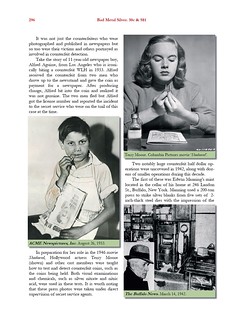 Topics covered include the history and reports of these counterfeit coins in circulation,
narratives about individual counterfeiters, adding these counterfeit coins into historical
context, documenting all die struck counterfeit half dollar and silver dollar varieties,
assembling counterfeit families, census data, XRF analysis of planchet alloys, die
states, errors, counterfeit coin dies and molds, numismatic values, and much more!
Topics covered include the history and reports of these counterfeit coins in circulation,
narratives about individual counterfeiters, adding these counterfeit coins into historical
context, documenting all die struck counterfeit half dollar and silver dollar varieties,
assembling counterfeit families, census data, XRF analysis of planchet alloys, die
states, errors, counterfeit coin dies and molds, numismatic values, and much more!
This is a beautiful, comprehensive volume that belongs on the bookshelf of every U.S. coin collector and especially those interested in contemporary counterfeit coins. "Bad Metal Silver. 50c to S$1. Circulating Contemporary Counterfeit United States Coins" is available for pre-order through August 2025 on BadMetalCoin.com for $75/shipped (U.S. only). Pre-Orders will be shipped as soon as July 2025.
Winston Zack is a numismatist specializing in the intriguing and often misunderstood history of contemporary counterfeit U.S. coins. He holds degrees in Anthropology, Archaeology, and Geography from the University of Arizona and University of North Texas. He has authored or co-authored four other numismatic books.
Publisher. Winston Zack (May 2, 2025)
Language. English
Hardcover. 400 pages
ISBN- 13: 979-8-9867345-1-4
Item Weight. 4 lbs
Dimensions. 8.5x11 inches
For more information, or to order, see:
Now Available. Bad Metal Silver. 50c to S$1
(https://www.badmetalcoin.com/product-page/now-available-bad-metal-silver-50c-to-s-1)
To read the earlier E-Sylum articles, see:
NEW BOOK: BAD METAL
(https://www.coinbooks.org/v22/esylum_v22n31a07.html)
NEW BOOK: BAD METAL: SILVER 3 TO 25 CENTS
(https://www.coinbooks.org/v25/esylum_v25n32a06.html)
MARVIN LESSEN (1934-2025)
Douglas Saville submitted this obituary of U.S.-based British coinage specialist and bibliophile Marvin Leeson. Thank you. Sorry to hear the news. -Editor
Baltimore MD. USA February 17, 1934 – April 3, 2025, Albany NY. USA
Marvin spent his youth in Baltimore, Hazleton, PA. and then in Albany. He earned his Batchelor's degree in Electrical Engineering from the University of Pennsylvania. He spent his career in the aerospace/defence industry, working in various locations - nationally in Boston, Alaska, and latterly in Los Angeles. In the early 1960's he was based in Scarborough and worked at Fylingdales in North Yorkshire.
Marvin was a collector by instinct - stamps, arms and armour, cameras - and coins. His time in England sparked a serious interest in British coins. In Scarborough he saw a Charles I or was it a Cromwell coin? amongst a handful of other coins on a plate in the window of an antique dealer, and purchased it. He started to become more and more interested in coins - and medals - of the period, and - was hooked. He became a member of the British Numismatic Society in October 1964, and subsequently a fellow of the Royal Numismatic Society. He subscribed to Seaby's Bulletin, and to Spink's Numismatic Circular, and whilst in Yorkshire Marvin got to know Corbitt and Hunter in Newcastle. When he returned to the USA he formed strong relationships with dealers with an interest in British coins - Chris Blom, Bill Castenholz, CNG, Dave Hess and Joel Malter.
Marvin moved to Culver City, near to Los Angeles in the 1970's, but his head and heart were still lingering in the UK. He had a large wall map of the UK in his apartment, with all the routes he had driven whilst he had been based there marked with a felt tipped pen - it was covered!
He was a skilled black and white photographer, and he loved listening to classical music of all kinds; an avid walker, he habitually walked 10 miles on a Sunday morning along the beach fronts in the LA area. On a visit I made to the area in the 1990's he challenged me to match him on his 10+ mile walk on one Sunday morning. I did with no real problem, and he was suitably impressed.
Along with his coins and medals, he formed a remarkably fine and complete library on all areas of British numismatics – mainly with the help of Howard Linecar and Douglas Saville at Spink and John Drury in England; and later through George Kolbe in the US. This helped him to produce a very large number of papers on mid-17th century numismatics. These were published in the pages of the British Numismatic Journal, the Numismatic Chronicle, Seaby's Bulletin, and Spink's Numismatic Circular. His main area of specialisation were the coins and medals of the mid-17th century, especially those of Oliver Cromwell, and the early years of Charles II.
His favourite numismatic author was Henry William Henfrey (1852-81), whose Numismata Cromwelliana, privately published in 1877, remains one of the truly significant pieces of numismatic research produced in Britain in the 19th century. Henfrey died of TB at the age of just 29 - a terrible loss to numismatics at the time. Marvin had at least 7 copies of Henfrey's work, in various states of preservation - one set was in the original parts, as published. I recall once finding a part - set of the Journal that Henfrey had edited whilst he was at school - we had never heard of it before, and it was a most important acquisition - he never managed to complete it.
Marvin's fine collection of coins and medals was sold by DNW (now Noonans) in London as "The North Yorkshire Moors Collection of British Coins" in four sales, between April 2018 and January 2021. A bibliography of his published work is published in those catalogues. His extensive library – packed in almost 100 large cartons - had already been shipped to the UK and was handled by Douglas Saville Numismatic Books. It resides, intact, within the library of a well-respected private collector in the UK, and is available to serious numismatic researchers.
Latterly Marvin was finding it less than easy to manage his day-to-day life, and he moved back to the east coast to be near to his family - his sister, Elaine, and his nephews Steven and Alan and families. In more recent years his health began to fail, and he was cared for by the Daughters of Sarah Nursing and Rehabilitation Center in Albany, NY.
Marvin will be remembered for having made a very significant contribution to our knowledge of the numismatics of Oliver Cromwell and the early years of Charles II.

A Marvin Lessen bibliography too lengthy to republish here is found in the Noonan's introduction to the sales of his collection. -Editor
To read the complete collection introduction, see:
The North Yorkshire Moors Collection of British Coins
(https://www.noonans.co.uk/auctions/archive/special-collections/769/collector/)
To read an online obituary, see:
Marvin Lessen Obituary
(https://www.legacy.com/us/obituaries/timesunion-albany/name/marvin-lessen-obituary?id=58293352)
DAVID L. GANZ (1951-2025)
Paul Whitnah passed along word of the passing of ANA Past President David Ganz. Thank you. Here is the announcement distributed to members of the Professional Numismatists Guild (PNG). Born July 28, 1951, he died May 20, 2025. -Editor
David L. Ganz a practicing attorney in New York and New Jersey, who served four terms as ranking (majority) member of the Bergen County, New Jersey Board of Chosen Freeholders, has died at 73 after a long battle with Parkinson's. He died peacefully in his sleep the morning of May 20th, according to his wife, Kathy.
Ganz also served seven consecutive one-year terms as Mayor of Fair Lawn, a borough whose population of more than 32,000 is 18th highest among New Jersey's 573 municipalities.
Ganz is the author of many books including Planning Your Rare Coin Retirement (1998); The Official Guide to U.S. Commemorative Coins (1999); The Smithsonian Guide to Coin Collecting (2008); Profitable Coin Collecting (2008); The Official Guide to State Quarters (2000); America's State Quarters (2008) and Small Claims Court Defense (2012). He was named a Numismatic Ambassador by Krause Publications in 2006.
From 1993 to 1995, Ganz was president of the Congressionally-chartered American Numismatic Association (ANA). In 1995, U.S. president Bill Clinton appointed him to the Citizens Commemorative Coin Advisory Committee, where along with Rep. Mike Castle (R-DE) he was credited with proposing the 50-State Quarters program, which earned $7 billion for American taxpayers over a 10-year period.
Ganz also served on the board of the Token and Medal Society, 1981 to 2006, and as its president, 2004 to 2006. He was a Life Fellow of the American Numismatic Society and had served on the board of directors for the Industry Council for Tangible Assets (ICTA). Ganz received the James U. Blanchard Lifetime Achievement Award from ICTA in 2009.
Throughout periods of his professional life, Ganz served in many legal-related capacities, including as an advisor to the ANA, ICTA, Professional Numismatists Guild and Numismatic Literary Guild.
Since 1965, he contributed more than 3,000 articles to various publications, with many of those articles focusing on numismatic-related topics and a number of them garnering prestigious literary awards.
To read the complete article, see:
David L. Ganz, Lawyer, NJ Politician and Prominent Coin Expert, Dies at 73
(https://www.pngdealers.org/blog_home.asp?display=52)
Here's an excerpt from a NorthJersey.com article. -Editor
David L. Ganz, former Fair Lawn mayor and a longtime member of the Bergen County Board of Chosen Freeholders, has died, the borough announced May 20.
His death was announced by the borough in a post on Facebook, which described Ganz as a "devoted public servant, community leader, and esteemed resident whose legacy has left a lasting imprint on Fair Lawn and beyond."
Ganz served as the 29th mayor of Fair Lawn. He was first elected to the Borough Council in 1997 and served five consecutive terms as mayor beginning in 1999. He also served on the Fair Lawn Zoning Board of Adjustment.
Outside of his service to Bergen County, Ganz was an attorney, author and numismatic expert. His legal career, during which he practiced with Ganz and Sivin, L.L.P., and Ganz and Hollinger, P.C., spanned litigation, municipal law, land use and guardianship.
He published numerous legal articles and books, including works on coin collecting and United States coinage legislation. His efforts helped establish the U.S. Mint's 50 State Quarters program, according to the borough's post. He previously served as the president of the American Numismatic Association, advising national and international coin programs.
"David L. Ganz was a dedicated public servant, a brilliant legal mind, a nationally respected expert in coin collecting, and most importantly - a kind and decent man who gave so much of himself to the people of Bergen County," said Tedesco. "David had an encyclopedic knowledge of government and New Jersey politics. He could quote statutes, recall budgets from memory, and go line-by-line through the most complicated financial documents - always with clarity and purpose."
To read the complete article, see:
Longtime Fair Lawn mayor and Bergen County freeholder David Ganz dies
(https://www.northjersey.com/story/news/bergen/fair-lawn/2025/05/20/david-ganz-fair-lawn-nj-mayor-bergen-freeholder-dies/83748038007/)
Pete Smith kindly provided these biographical notes. -Editor
Ganz, David L(awrence) 48th ANA President, Writer, Lawyer
Born in New York City. Received B.S.F.S. from Georgetown University in 1973 and J.D. from St. John's University Law School in 1976. He has done postgraduate study at New York University Law School. He was admitted to the bar in New York in 1977, D.C. in 1980, New Jersey in 1985.
Since 1981 he has been a member of the law firm of Ganz, Hollinger & Towe; renamed Ganz & Hollinger. Also a member of Ganz & Sivin, LLP. In Fair Lawn after 1985. He has specialized in the law relating to numismatics. He served as counsel at various times for Bowers & Ruddy Galleries, Numismatic Fine Arts, Stacks, and the four firms involved with the "Apostrophe" sales. He serves as general counsel for the Professional Numismatists Guild, the Numismatic Literary Guild and the Token & Medal Society. He was Legislative Counsel for the ANA 1978 to 1981 and continued 1983 to 1995.
He was elected to the ANA board of governors and served 1985 to 1991; vice president 1991-93; elected president serving 1993 to 1995. Served on the Board of TAMS 1981 to 2006 and as president 2004 to 2006. Life 4. Fellow of the ANS, Associate Member 1974-1985, Fellow 1985 to 1992.
He has served on the board of directors for the Industry Council for Tangible Assets after 1983. Received James U. Blanchard Lifetime Achievement Award from ICTA 2009. Director of The Coalition for Equitable Regulation & Taxation.
He served on the Assay Commission for 1974. He was a consultant to the Subcommittee on Historic Preservation & Coinage of the House Committee on Banking, Housing & Urban Affairs. He was a consultant for the Canadian Olympic Coin Program, FAO coin program, Moscow Olympic coin program and the Statue of Liberty coin program. Appointed by Act of Congress to the design panel for 1992 James Madison – Bill of Rights Coin and 1996 Olympic Coinage. Founding member of the Citizens Commemorative Coin Advisory Committee and served 1993 to 1996. While on the committee he was a strong advocate for the 50 states quarter program.
 Since 1965 he has contributed more than 3000 articles
to various publications. Many were on numismatic topics.
He was on the editorial staff of Numismatic News.
Contributed "Under the Glass" to The Coin Shopper in
1965, then in Coin Collector in 1967 and to NN 1969-1975. He was Washington correspondent from November
1969 to May 1973. Editor of an ANA publication The
Young Numismatist 1971-1974. Author of 14 Bits, the
story of the Bicentennial coinage, in 1976. He contributed
the "Backgrounder" column to Coin World in after
February 16, 1977.
Since 1965 he has contributed more than 3000 articles
to various publications. Many were on numismatic topics.
He was on the editorial staff of Numismatic News.
Contributed "Under the Glass" to The Coin Shopper in
1965, then in Coin Collector in 1967 and to NN 1969-1975. He was Washington correspondent from November
1969 to May 1973. Editor of an ANA publication The
Young Numismatist 1971-1974. Author of 14 Bits, the
story of the Bicentennial coinage, in 1976. He contributed
the "Backgrounder" column to Coin World in after
February 16, 1977.
Author of The World of Coins and Coin Collecting issued in 1980 at $19.95. His articles have appeared in COINS magazine, COINage magazine, Coin World and The Numismatist. Ganz was editor of "Numismatics and the Law" in Coin World Almanac, 3rd, 4th, 5th and 6th editions.
In 1990 Ganz won the NLG Clemy Award for his contributions. In 1991 he became editor of the NLG Newsletter and served until 1996. His "Under the Glass" column resumed in Numismatic News September 10, 1996. He wrote "Coin Market Insider's Report for COINage Magazine 1974 to 2010.
Author of Planning Your Rare Coin Retirement (1998); The Official Guide to U.S. Commemorative Coins (1999); Smithsonian Guide to Coin Collecting (2008); Profitable Coin Collecting (2008); Official Guide to State Quarters (2000) and America's State Quarters (2008).
Mike Costanzo writes:
"Sad to hear about the passing of David Ganz. Years ago, I purchased a vintage pair of civilian medal hub dies dating from WWII. The seller said he was cleaning out a GSA government warehouse (remember them? The Carson City dollar people!) back in the 1980's and found them. He liked them and his supervisor said to go ahead and keep them. Soon after I bought them I had the nagging feeling that perhaps I shouldn't be owning them. I know the only person who could answer this would be David Ganz. I contacted David and within days he answered back that anything that was ever the property of the U.S. Government was still their property, unless you had a clear receipt of sale.
"I was impressed with David's knowledge of legal matters (he was, after all, THE prominent legal mind for numismatic matters) and how gracious his response was. But most of all, it was the only time I ever got legal advice from an attorney and didn't receive a bill! He is already missed."
My own interactions with David over the years have also been good ones. He was an early E-Sylum subscriber and an occasional contributor. I was honored to receive the ANA Presidential Award under his tenure in August 1995. His 14 Bits mongraph on the U.S. bicentennial coinage is one of my favorites, going behind the scenes of the creation of these iconic designs. -Editor
To read other coverage, see:
Numismatic leader David L. Ganz passes at 75
(https://www.coinworld.com/news/us-coins/numismatic-leader-david-l-ganz-passes-at-75)
Former ANA President David Ganz Has Died
(https://coinweek.com/former-ana-president-david-ganz-has-died/)
To read earlier E-Sylum articles, see:
REMEMBRANCES OF HANS M. F. SCHULMAN
(https://www.coinbooks.org/esylum_v08n25a17.html)
ON EDITORIALS AND THE LATEST ANA DUST-UP
(https://www.coinbooks.org/esylum_v08n47a17.html)
BOOK REVIEW: SMITHSONIAN GUIDE TO COIN COLLECTING BY DAVID GANZ
(https://www.coinbooks.org/esylum_v11n16a03.html)
DAVID GANZ RECALLS HIS TRAVELS AND WRITINGS
(https://www.coinbooks.org/esylum_v16n09a16.html)
ON THE LEGALITY OF OWNING ALUMINUM CENTS
(https://www.coinbooks.org/esylum_v17n06a17.html)
DAVID GANZ ON FRANKLIN MINT FOUNDER JOSEPH SEGEL
(https://www.coinbooks.org/esylum_v18n14a06.html)
NEWMAN GRANTS 2025 AWARD ANNOUNCEMENT
Len Augsburger provided this announcement of the 2025 Newman Grants on May 25th, the birthday of the late Eric P. Newman. Congratulations to the recipients - some great projects outlined here. -Editor
Eric P. Newman Numismatic Education Society Announces Newman Grants
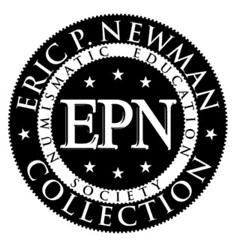 The Eric P. Newman Numismatic Education Society (EPNNES) today announces its sixth set of Newman
Grants, created to financially assist numismatic authors and organizations pursuing original research in
American and world numismatics. Newman Grants are awarded annually on the late Eric P. Newman's
birthday and assist with direct costs of numismatic research such as travel, photography, and graphic
arts services.
The Eric P. Newman Numismatic Education Society (EPNNES) today announces its sixth set of Newman
Grants, created to financially assist numismatic authors and organizations pursuing original research in
American and world numismatics. Newman Grants are awarded annually on the late Eric P. Newman's
birthday and assist with direct costs of numismatic research such as travel, photography, and graphic
arts services.
Five awards are being made this year, touching on varied aspects of American numismatics. The 2025 Newman Grant awardees are as follows:
Greg Bennick will conduct oral history interviews with prominent numismatists and will document these voices for future generations of collectors and researchers.
John Frost will travel to San Bruno, CA to work with U.S. Mint material at the National Archives, in preparation for a second edition of his work Double Dimes - the United States Twenty-Cent Piece, of which the first edition was co-authored with the late Lane Brunner.
Kent Halland will research U.S. Postal Notes, which were used to transmit small amounts of money via the post office in the late 19 th century.
Pam Herrick will manage digitization of the Gilroy Roberts archive at the Community College of Philadelphia, focusing on the Roberts plaster casts. Roberts is well-known as the engraver of the Kennedy half dollar obverse.
Patrick McMahon will research the Rebecca Salisbury scrapbooks at Yale University. Salisbury was one of the earliest female American numismatists.
It is the hope of EPNNES that this program will continue the legacy of Eric P. Newman in a way that would reflect his high standards for numismatic research.
MEMORIAL DAY AND THE G.A.R.
Newman Numismatic Portal Project Coordinator Len Augsburger provided this timely report on Memorial Day and the Grand Army of the Republic. -Editor
Memorial Day & The Grand Army Republic
Memorial Day originated in the aftermath of the American Civil War as a solemn day of remembrance for those who died in military service. Initially known as Decoration Day, it began informally when citizens across the country began decorating the graves of fallen soldiers with flowers. The first widely recognized observance occurred on May 30, 1868, when General John A. Logan, commander-in-chief of the Grand Army of the Republic (GAR)—a fraternal organization composed of Union veterans—issued General Order No. 11, designating the day for "strewing with flowers, or otherwise decorating the graves of comrades who died in defense of their country." This act formalized the practice and established a tradition that quickly spread across Northern states.
The Grand Army of the Republic played a crucial role in institutionalizing Memorial Day as a national observance. As a powerful and politically influential veterans' organization, the GAR organized annual ceremonies, lobbied for public recognition, and helped entrench the day's meaning in American civic life. Through parades, speeches, and grave-decorating rituals, the GAR used Memorial Day to honor the Union cause, assert the moral legacy of the Civil War, and promote patriotism. Over time, the observance evolved to commemorate all American military personnel who died in service, but its roots remain firmly planted in the post-Civil War efforts of the GAR and its mission to preserve the memory of those who fought to preserve the Union.
Numismatically, the Grand Army commissioned a series of medals, most notably issues related to annual encampments that occurred throughout the country. In the first two issues of the 2012 TAMS Journal, David Schenkman provided an overview of souvenirs related to the 1892 Washington, D.C. encampment. GAR membership and officer badges are frequently seen along with the medals. The Grand Army series finally includes standalone issues, such as a 1909 Lincoln birth centennial medal.
Images: 1882 Grand Army of the Republic, 16th National Encampment at Baltimore Medal. Ex. Stack's Bowers April 2024 Collectors Choice Online Auction, lot 72469, realized $264. Images courtesy of Stack's Bowers.
Link to 2012 TAMS Journals on NNP:
https://nnp.wustl.edu/library/publisherdetail/515304?Year=2012&displayAmt=50
VIDEO: LOCAL CURRENCIES AND COINS
The David Lisot Video Library on the Newman Numismatic Portal can be found at:
https://nnp.wustl.edu/library/multimediadetail/522852
We highlight one of his videos each week in The E-Sylum. Here's one from 2009 with Oded Paz speaking about local currencies. -Editor
There are many reasons for issuing local currency and coins; most are meant to be alternative currencies to those that are "legal tender." This presentation looks at a few of these "local authorities" that minted this currency. They did this as an instrument of banking and finance, and to increase the usage of local currencies, thus enhancing trade. Some of these issues are serious about their reasons; some do it with a wink and a smile. Oded Paz is the founder and president of the Unrecognized States Numismatic Society and is an ANA District Representative. His is a frequent lecturer at ANA shows and conventions across the country.
Speaker(s): Oded Paz.
To watch the complete video, see:
Local Currencies and Coins: Instruments of Banking and Finance
(https://youtu.be/etJKU-PilAM)
Local Currencies and Coins: Instruments of Banking and Finance
(https://nnp.wustl.edu/library/book/557332)
Here's one of the local currencies discussed in the video. -Editor
To read the complete item description, see:
Mattole 10 Petols X# 1
(https://www.ngccoin.com/price-guide/world/mattole-10-petols-x-1-2007-cuid-1183876-duid-1457508)
NOTES FROM E-SYLUM READERS: MAY 25, 2025
Sandrock's Ancient Chinese Cash Notes Found
One of the last items I added to last week's issue was Ed Cohen's request for a copy of Sandrock's Ancient Chinese Cash Notes. I managed to find one offered online. -Editor
Ed writes:
 "Wow! Fast reply and a successful find. I ordered the dealer's last copy from Ebay.
"Wow! Fast reply and a successful find. I ordered the dealer's last copy from Ebay.
"I'm working with the editor and a reviewer of Historum Mathematica (an Elsevier journal on History of Mathematics).
"He was also seeking a copy. The early Chinese paper money issued by the Southern Song (12th-13th centuries CE) is a useful source showing how the Chinese of that time treated numbers.
"Much thanks. If there are other copies out there, that will be useful."
To read the earlier E-Sylum article, see:
NOTES FROM E-SYLUM READERS: MAY 18, 2025 : Sandrock's Ancient Chinese Cash Notes Sought
(https://www.coinbooks.org/v28/esylum_v28n20a10.html)
Designs for the 2026 U.S. Semiquincentennial
Wayne Pearson writes:
"Nearly 50 years ago, (July 7, 1975), the bicentennial coins were first released. I really dread the designs we're going to get for 2026."
The news has been quiet, and the clock is ticking. Below is a YouTube video with proposed designs for the 2026 Semiquincentennial reviewed by the Citizen's Coinage Advisory Committee (CCAC).
-Editor
To watch the video, see:
2026 250th Anniversary Coin Designs Proposed
(https://www.youtube.com/watch?v=8XttcBmP5jY)
To sign up for U.S. Mint product notifications, see:
https://www.usmint.gov/coins/coin-programs/semiquincentennial/
Wayne's been thinking about paper money designs as well. Here's the back of a $250 bill idea. -Editor
Max Herrmann's New Money System
Jim Haas writes:
"In the course of researching an article on this man's daughter, an artist, I came upon this gem. Max was no fruitcake, but sadly, this was the only mention of it. He died in 1942."
Interesting. 34 years? Must have been quite a system. Perhaps copies of his plan can be found in the National Archives. The article is from the North Shore Daily Journal January 15, 1936. -Editor
Cowboy Coin Contest
In the this-is-why-your-mom-told-you-not-to-put-coins-in-your-mouth department, I wanted to add this numismatic tidbit from Garrison Keillor's blog. I usually try to have an image with each item, but you'll have to use your imagination on this one. -Editor
Senator Simpson listened to a radio show I used to do and he wrote me a fan letter on official stationery and once, when I was in Washington, I had coffee with him and he told me a story about a contest that cowboys used to conduct when he was a boy. They'd take turns dropping their trousers and competing to see who could pick up a silver dollar using only his bare buttocks, and if necessary, have a playoff for a half-dollar or a quarter. There was a genuineness about the man that was pure gold. I knew he was a conservative and it didn't matter; what was important was the integrity.
To read the earlier E-Sylum article, see:
What I saw Sunday in New York
(https://garrisonkeillor.substack.com/p/what-i-saw-sunday-in-new-york-5f4)
LOST MINT DOCUMENTS FOUND
Researcher Roger Burdette has spent years working in the National Archives and Records Administration (NARA) locating, digitizing and transcribing documents relating to the U.S. Mint. Here are his comments on a large group of documents that had been thought missing but Roger managed to locate with the assistance of digitization. A wonderful development. -Editor
 The current Finding Aid for Record Group 104, United States Mint, is the "Preliminary
Inventory of the Records of the Bureau of the Mint" compiled by Forrest R. Holdcamper,
January 1968, as identified on the cover page.
The current Finding Aid for Record Group 104, United States Mint, is the "Preliminary
Inventory of the Records of the Bureau of the Mint" compiled by Forrest R. Holdcamper,
January 1968, as identified on the cover page.
The final 26 pages of this Finding Aid consist of degraded photocopies of several hundred documents that were collected at the Philadelphia Mint by WPA employees sometime before October 12, 1936, and later compiled by L. J. Holverstott (May 1, 1947). Almost all of the listed documents are of a general correspondence nature and would be expected to be at NARA Philadelphia in RG104 Entry 1 "General Correspondence, 1792-1899." However, they have not been found.
Researchers in RG104 have long wondered if these documents were at the Philadelphia Mint, on rotating display at some Government building, or possibly lost. Inquiries of NARA Archivists were unsuccessful.
In an attempt to locate these documents, the writer made a complete transcription of the 26 page list at the end of the current Finding Aid. Although many entries were nearly illegible, the writer matched key words and names against the writer's database of digitized RG104 documents. This resulted in cross matches of identical or similar documents (by date, subject, correspondents) that had been misfiled.
The result is that the writer discovered that almost all of the documents exist. They were returned to Philadelphia NARA RG104 E-1, but not refiled in chronological order. Instead, they were put into file boxes #203, 204 and 205 and "added" to the end of the long run of Entry 1 "General Correspondence, 1792-1899" with only an obscure box label to identify them.
The found documents are dated from 1795 through 1888. Here are a number of descriptions that caught my eye. Any one of these could be fodder for an interesting article reference in a future book. -Editor
- Charges by George Breining, workman at Mint, against Chief Coiner, Henry Voigt. (1833)
- John Appleton, Asst. Secretary of State, to James Ross Snowden, Director of the Mint, relative to cost of striking medals. (1859)
- Fred. T. Frelinghuysen, Dept. of State, to Hon. Charles J. Folger, enclosing an impression of the great seal of the U.S. (1882)
- Samuel Moore to Franklin Peale, relating to trip to Europe on behalf of the United States Mint. (1833)
- Rufus Tyler, New Orleans, to Dr. R. M. Patterson, Director of the Mint, submitting his views in re incompetency of the Supt. Mr. Bradford, etc. (1839)
- Letter of recommendation from D. Hord, Chief Engineer, N.O. & N. R.R. to Dr. R. M. Patterson, Director of the Mint, recommending Philos B. Tyler for Coiner in New Orleans Mint. (1839)
- R. M.P. to Rufus Tyler, New Orleans, regarding spread of yellow fever among employees of the New Orleans Mint. (1839)
- John Forsyth, Secretary of State, to Samuel Moore, Director of Mint, authorizing preparation of 2 sets of coins of the United States with instructions for delivering same. (1835)
- R.P.M., Dir. to Hon. George W. Crawford, Sec. of War, regarding the engaging of C.C. Wright, of New York, for engraving the dies for Gen. Scott and Gen. Taylor Medals.(1849)
- Press copy of letter from James Ross Snowden, Dir. of the Mint, Phila., to John C. Deveraux, Esq., Phila., re-establishment of Medal Dept. (1854)
- Henry Voigt, Chief Coiner, report to Director of the Mint January 12, 1798, requesting more horsepower.
- Original letter from inventor Contamin describing the first die cutting machine purchased by the U.S. Mint from Paris, dated November 1, 1836.
- Framed letter dated December 11, 1848 D/M Patterson from Hon. Robt. J. Walker Sec. Tr. on first deposit gold from California
- Draft of Rules for sale of American Medals and Cabinet Coins (unsigned), with price list of medals attached. (1873)
Roger adds:
"It shows how digitization of archival documents can be used to facilitate recovery of items once thought "lost." The work could only be accomplished through use of digital images provided by the Newman Numismatic Portal (NNP), and my extensive database.
"I sent this on to NARA so they could cross reference for future researchers."
REWARD FOR STOLEN CONNECTICUT COPPER
Jeff Rock submitted this notice of a reward offer for a stolen Connecticut copper. Can anyone help locate it? -Editor
$5,000 NO-QUESTIONS-ASKED REWARD OFFERED
Last year I sold the above 1786 Connecticut copper, Miller 5.3-B.2 to a private collector. It was sent via registered mail, but was never delivered to its new owner. The Post Office has been unable to locate it – and even though registered mail is supposed to be signed for at every step, this package never was. It was either lost or, more likely, stolen in transit. The owner and I have decided to offer a $5,000 reward for the safe return of the coin – with no questions asked, and no legal repercussions as a result of that return. As the coin cannot legally be sold since it lacks clear title and has been reported as stolen to authorities, we hope this reward will ensure a return of this coin.
The piece is immediately recognizable, one of just four known examples of this variety, and considered to be the finest of the four, a little weaker but more attractive than Ford coin which was uncirculated but with heavy planchet flaws. This coins is ex Col. James Ellsworth Collection; Garrett Collection, Part III, October 1980, lot 1345; Anthony Terranova Collection, January 2012, and most recently in the Sydney Martin collection, October 2022, lot 1334. It is plated in Walter Breen's Complete Encyclopedia of U.S. and Colonial Coins, and in Randy Clark's The Identification and Classification of Connecticut Coppers 1785-1788.
 When mailed it was in a PCGS slab with the Syd Martin provenance given, graded AU53, though the coin could have been removed from the slab at any point after it went missing.
When mailed it was in a PCGS slab with the Syd Martin provenance given, graded AU53, though the coin could have been removed from the slab at any point after it went missing.
If anyone knows of this coin, or has been offered it, please get in touch with Jeff Rock at (619) 929-7926 or at rosaamltd@gmail.com. Any contact will be completely confidential, and the $5,000 reward will be sent upon the safe return of the coin – again, with no questions asked.
The coin illustrated above is the actual specimen that went missing, and the image to the right shows the coin in the PCGS slab.
COPPERS OF GEORGE WASHINGTON'S AMERICA
Mike Markowitz wrote up this summary of the presentation John Kraljevich gave on Tuesday, May 13 to the Fairfax Coin Club on "The Coppers of George Washington's America: 1732-1799." Thanks - sorry I had to miss this one! -Editor
George Washington's Coppers
 At the well-attended Fairfax Coin Club meeting on Tuesday, May 13 at the Vienna
Community Center, John Kraljevich gave a talk on "The Coppers of George
Washington's America: 1732-1799." Kraljevich, an expert on the coinage of
Colonial America, is Director of Numismatic Americana for Stack's Bowers
Galleries, a leading auction house. ( https://stacksbowers.com/ )
At the well-attended Fairfax Coin Club meeting on Tuesday, May 13 at the Vienna
Community Center, John Kraljevich gave a talk on "The Coppers of George
Washington's America: 1732-1799." Kraljevich, an expert on the coinage of
Colonial America, is Director of Numismatic Americana for Stack's Bowers
Galleries, a leading auction house. ( https://stacksbowers.com/ )
Although scarce gold and silver coins of many nations circulated in early America based on their bullion value, humble copper coins used as small change were basically just tokens, not "legal tender." Kraljevich explained that "if it was small and round and brown, it passed as a copper." Officially, 96 coppers exchanged for one Spanish milled dollar, but in the "Copper Panic of 1789" ( https://en.wikipedia.org/wiki/Copper_Panic_of_1789) when the colonies were flooded with lightweight counterfeits, the rate rose as high as 180.
The Red Book, issued annually since 1947 is the standard reference for collectors of American coins, but it is not a good guide to what actually circulated in America during George Washington's life. The Red Book contains many costly rarities that most Americans of the era would never have seen, it excludes many foreign types that circulated widely, and the inclusion of items in the book is often based more on "tradition" than evidence.
Our modern understanding of the circulating coinage in the 18th century is based largely on archaeology, metal detector finds, and surviving documentary evidence. The most common copper coins of Colonial America were half pennies of George III (who ruled from 1760 to 1820), which were widely counterfeited - in fact fakes were more common than genuine pieces.
Kraljevich noted that the only "official" copper coin of colonial America was the Virginia half penny of 1773-1774. (https://emuseum.history.org/objects/67961/virginia-12d-no-period )
The talk was well-illustrated, with photos of many examples found in excavations in and around Virginia. Many thanks to John for a most informative and enjoyable talk.
For more information on the Fairfax Coin Club, see:
https://fairfaxcoinclub.com/
VOCABULARY TERM: REVERSE
Here's another entry from Dick Johnson's Encyclopedia of Coin and Medal Terminology. I added the image from a 2016 Heritage lot listing. -Editor
Reverse. The back or opposite side to the obverse. The symbolism or allegory on the reverse must supplement or support the principle device on the obverse. Designers claim the reverse is often the more difficult side to design, since the obverse is the principle theme – usually an easy design concept – the reverse is more difficult since it must complement the obverse and further develop the total theme of the coin or medal design.
 An interesting Washington-Lincoln Medal has the word reverse on the medal. King 856 (Baker 240) bears Washington on the obverse with the famous slogan First in war, first in peace ..." The opposite side bears Lincoln with "reverse" as its legend. Some numismatic writers believe this is the diesinkers misunderstanding, that he put his instructions as the legend, rather than some appropriate lettering.
An interesting Washington-Lincoln Medal has the word reverse on the medal. King 856 (Baker 240) bears Washington on the obverse with the famous slogan First in war, first in peace ..." The opposite side bears Lincoln with "reverse" as its legend. Some numismatic writers believe this is the diesinkers misunderstanding, that he put his instructions as the legend, rather than some appropriate lettering.
To read the complete entry on the Newman Numismatic Portal, see:
Reverse
(https://nnp.wustl.edu/library/dictionarydetail/516644)
PATRICK W. BARNARD (1940-2017)
E-Sylum Feature Writer and American Numismatic Biographies author Pete Smith submitted this article on New York token book author Pat Barnard. Thanks! -Editor
 I could write about people who are familiar names in numismatics. I prefer to tell a story that no
one has read before. Pat Barnard was a little-known author of an obscure numismatic reference. I
thank John Mutch for suggesting this topic.
I could write about people who are familiar names in numismatics. I prefer to tell a story that no
one has read before. Pat Barnard was a little-known author of an obscure numismatic reference. I
thank John Mutch for suggesting this topic.
Patrick W. Barnard was born in Niagara Falls, New York, on August 20, 1940. He was the son of William Earl Barnard (1902-1967) and Nora Josephine O'Grady Barnard (Pruester) (1920-2003).
In some ways, the story of William Barnard and his family is more interesting than the story of Patrick. William married Thelma Elnora Smith (1906-1946) on October 6. 1923. They got busy producing a family and by the 1930 Census in Lockport, New York, they had a son Robert William Barnard (1925-1967) and two daughters, Betty Lou Barnard (1926-1993) and Mary Ann Barnard (1929-2006). The marriage ended in divorce on August 26. 1940.
The family had changed by 1940. The 1940 Census, taken at Niagara Falls on April 8. 1940, shows William, age 37, living with his wife, Nora, age 20, his son, Robert, age 15, and daughter, Mary Ann, age 10. Betty Lou was not listed. His first wife, Thelma, was living alone and working as a waitress.
Also on the record was Michael Barnard, age 9/12. In the Census, the first names of children are listed under their parents. Although he was indexed as Michael Barnard, I believe he was actually Michael O'Grady, the son of Nora.
Patrick and Nora also got busy having children. By the 1950 Census, Nora was living in Niagara Falls with her sons, Patrick W., age 9. John Russell Barnard (1941-1997), age 8, David E. Barnard (1943- ), age 7, and Thomas J. Barnard, age 10/12 (1949- ). William and Michael were not included with the family listing.
In her 2003 obituary, Nora's surviving sons were Patrick W. Barnard of North Tonawanda, Michael D. O'Grady of Los Lumas, New Mexico, and Thomas J. Barnard of Fort Lauderdale, Florida.
Patrick Barnard enlisted in the United States Marine Corps fresh out of high school in 1957.
He married Carole Camp Barnard and had two daughters.
Patrick taught social studies at Tonawanda and was a coach of the track and cross-country teams at Tonawanda High School before retirement in 1995.
He was president of the Historical Society of the Tonawandas. He collected historical items from the area and specialized in local tokens.
Barnard was a member of the CWTS and TAMS. He submitted one article to a numismatic periodical.
"The Elusive Merchant: M. W. Walsh of Niagara Falls, NY" in Civil War Token Journal, 3/1/2003. For this he received an Honorable Mention from CWTS.
He died on December 13, 2017, at home in North Tonawanda, New York, and is buried at Mount Olivet Cemetery in Kenmore, New York.
Barnard wrote Western New York Tokens, published with 314 pages in 2013. There was no publisher noted which suggests that it was self-published. The book covers tokens from the eight western counties in the state: Allegany, Cattaraugus, Chautauqua, Erie, Genesee, Niagara, Orleans and Wyoming. He suggested a supplement might be made after five years but he did not live to see that.
 He placed ads in the TAMS Journal in 2014, although the title was not mentioned. Also in 2014,
he received a third place Mishler Cataloging Award from TAMS for Western New York Tokens. A
reference to the award is the only time the book title appears in the Newman Numismatic Portal.
He placed ads in the TAMS Journal in 2014, although the title was not mentioned. Also in 2014,
he received a third place Mishler Cataloging Award from TAMS for Western New York Tokens. A
reference to the award is the only time the book title appears in the Newman Numismatic Portal.
Neither Barnard or the title of his book were mentioned in The Numismatist. They are not listed by The Library of Congress.
While working on this article, about 20% of my time went into information on Patrick Barnard. The other 80% went down a rabbit hole trying to figure out William Earl Barnard, Nora Josephine O'Grady and Michael D. O'Grady. I was frustrated that I could not find a marriage or divorce record for William and Nora or a complete birth record for Michael. I would like to know how the dates of her marriage coordinate with the births of Michael and Thomas.
NUMISMAGRAM MEDAL SELECTIONS: MAY 25, 2025
Jeremy Bostwick with Numismagram forwarded these four medals from his most recent upload of new material to his site. For all of the new items, please visit https://www.numismagram.com/inventory. -Editor
103190 | PHILIPPINES & UNITED STATES. Louisiana Purchase/St. Louis International Exposition bronze award Medal. Issued 1904. Presented at the expo for the "bronze" award at the Filipino Exhibit (63mm, 12h). Round shape. By Adolph Alexander Weinman at the Philadelphia mint. VNIVERSAL EXPOSITION SAINT LOVIS VNITED STATES OF AMERICA, Columbia standing slightly right, wearing Phrygian cap and outstretching American flag over Native American maiden standing to right, removing flag with intricate bee design (representing industriousness); rising sun in background // Eagle, with head left and wings spread, standing facing on oak and laurel branches; below, rectangular cartouche decorated with scallop shell and inscribed • BRONZE • MEDAL • / • PHILIPPINE • EXHIBIT • / • LOVISIANA • PVRCHASE • / • EXPOSITION • in four lines; two inward-facing dolphins below. Hendershott 30-41; Honeycutt 70c. NGC AU Details—Environmental Damage. Red-brown surfaces, with some light handling and mild mottling of the color from the noted environmental damage. This aspect, however, does not interfere with its overall appearance, charm, and rarity. A very rare subset of the more typically encountered general award specifically designed for the Filipino exhibit and with a mintage of just 975 pieces. Fairly comparable to the McFadden specimen, an NGC AU-55, though clearly with some environmental issues of its own, and for which its current owner wants at least $1,800 (via HA) $1,495.
Designed by famed German-born U.S. coinage engraver Adolph Alexander Weinman, this series of award medals displays the elegant artistry that would make appearances the following decade on the 'Mercury' dime and the 'Walking Liberty' half dollar. Issued in various shapes, the entire series (bronze, silver, gold, commemorative, and grand) were nominally named, as all of the award medals were struck in a new bronze alloy (initially referred to as 'government bronze'), and meant to convey the level of recognition for the recipient. The expo itself was held in St. Louis, Missouri, and had, as its backdrop, the centennial of the Louisiana Purchase to commemorate—a factor which prominently influenced many design aspects of the award medals.
To read the complete item description, see:
103190 | PHILIPPINES & UNITED STATES. St. Louis Int'l Expo bronze Award Medal.
(https://www.numismagram.com/product-page/103190)
102809 | SWEDEN. Edvard Swartz silver Medal. Issued 1936. Commemorating the life of the stage actor (45mm, 43.68 g, 12h). By Erik Lindberg at the Stockholm mint. EDVARD SWARTZ NAT MDCCCXXVI OB MDCCCXCVII, bust right, wearing frock coat // TRAGŒDUS VERBA POETARUM SUMMA ARTE ILLUSTRAVIT (as a tragic actor, he interpreted with consummate mastery the works of the great poets), Swartz, as a younger man (standing left, holding skull), in the role of Hamlet in the "alas, poor Yorick" scene. Edge: SILVER 1936. Ehrensvärd 359. Mintage: 125. Choice Mint State. Alluring gunmetal gray toning, with some enchanting iridescence and a great matte nature. $195.
One of the star actors in Sweden's Royal Dramatic Theater in the mid-19th century, Swartz was seen as a tremendous talent in tragic and heroic roles, portraying numerous popular characters throughout his career. At one point, his physical appearance was so striking that the papers referred to a "Swartzjuka," or "Swartz illness," on account of the clamor that he created among the audience.
To read the complete item description, see:
102809 | SWEDEN. Edvard Swartz silver Medal.
(https://www.numismagram.com/product-page/102809)
102826 | VATICAN CITY. Pope Pius XII silver Medal. Issued 1946/Year VIII. Commemorating the Papal Consistory (44mm, 36.82 g, 12h). By Aurelio Mistruzzi at the Rome mint. PIVS • XII • PONT • MAX • ANNO • VIII, bust right, wearing stole and zucchetto // + E • QVINQVE • TERRARVM • ORBIS • PARTIBVS • XXXII • CARDINALIBVS • CREATIS, view of the central nave of St. Peter's Basilica during the Consistory. Edge: Plain. Bartolotti E946; Rinaldi 140; Cusumano-Modesti 56. Gem Mint State. Extremely lustrous and mirrored, with intense colorful toning as well, along with great depth on the reverse that creates an intense 3D effect. $245.
Consistories in Catholicism represent times at which a pope can create new cardinals, adding them to the College of Cardinals. Due to death or retirement, the number of cardinals decreases, creating the need for periodic additions during such consistories. Pius XII was elected to the papacy in 1939 during a conclave consisting of 62 cardinals. The first of two consistories under his reign did not occur until 1946, as the conflicts of World War II created a necessary hiatus. His only other consistory was in 1953, 5-1/2 years before his death in 1958.
To read the complete item description, see:
102826 | ITALY. Vatican City. Pope Pius XII silver Medal.
(https://www.numismagram.com/product-page/102826)
103129 | JAPAN & UNITED STATES. "Newborn" oval cast bronze Medal. Issued circa 2005 (80mm x 88mm, 224.25 g). By Kazuhiro Adachi for the First International Medallic Sculpture Competition for Emerging Artists (where it won the Cast Bronze Award). Head of infant facing slightly left // Blank except for "Newborn" and K. ADACHI. Edge: Some filing marks as made, otherwise plain. As Made. Brassy-yellow surfaces. A unique example of an award-winning medal. Ex David Baruch Simpson Collection (acquired from Medialia's Rack and Hamper Gallery). $265.
Adachi exhibited this unique offering, along with two others, as part of a group exhibition entitled "The Portrait" and displayed at Medialia's Rack and Hamper Gallery from 31 January–14 February 2007 in New York City. The gallery's description of the exhibition reads "...Portraits are an ever present subject matter for the visual artist. One's own face, or the face of another, possesses an unlimited source of interpretation. It is an avenue into the character and personality of the individual. In this exhibition, the portrait is not confined to the classical sense of the word. The artists in this exhibition convey emotions and concepts through this medium, enabling them to recreate their subject."
To read the complete item description, see:
103129 | JAPAN & UNITED STATES. "Infant" oval cast bronze Medal.
(https://www.numismagram.com/product-page/103129)
NOONANS TO SELL BRITISH IRON AGE COIN HOARD
Noonans Mayfair will be selling a hoard of 67 British Iron Age Coins on Thursday, May 29, 2025. -Garrett
67 British Iron Age Coins (silver staters) discovered over a five-day period in April 2022 by a 90-year-old metal detectorist buried by a fence within a remote Dorset meadow in Cranborne are estimated to fetch in the region of £20,000 at Noonans Mayfair in a sale of Coins, Historical Medals and Numismatic Books on Thursday, May 29, 2025.
As the finder, who lives just 15 miles away from the discovery location and wishes to remain anonymous recalled: "I have been metal detecting since 2002 and on the day that I found the staters, at about midday, it was nice and clear weather."
He continued: "I was out detecting during a club meeting using my White XLT detector and initially found a Victorian penny buried by the gateway. I sat by a nearby tree for lunch and pondered whether there would be more in that spot, so I decided to persevere and continue digging, but rather than finding more pennies, something silver popped up. Without a doubt, I knew what I had found, a silver stater of the Durotrigan people. My fellow detectorists offered their assistance and eventually 67 Staters were unearthed. The fence was wrapped in wire which confused the metal detector's signals, but after removing the wire with permission from the landowner, no more coins were found. The fence by the find spot was placed at some time during the 1800s. During this process, there is a good chance that the hoard was broken up."
He finishes: "This hoard was a truly exciting find, but slightly tempered at the thought that it was someone's considerable loss."
Before taking up metal detecting, the finder was a professional diver, which inspired him to start metal detecting as he was interested in shipwrecks and treasure. He notified the finds liaison officer the next working day after finding the hoard, however no museums or experts have been involved, but Dr John Talbot will be including a study of the hoard in his upcoming book about Durotrigan coinages, which is due to be published in the next 2-3 years. The finder will share the money with the landowner, but he has no set plans with what to do with the funds raised, other than to enjoy it!
Noonans Coin Specialist Alice Cullen continues the story: "It is thought that the coins may have initially been buried together as one deposit, supported by the fact that many of the coins were found in clusters. However, no vessel was found. There is no place better to find Cranborne type staters, than in Cranborne itself! The coins may have even been deposited as a ritual offering, suggesting that perhaps nothing untoward happened at all."
She adds: "This hoard in particular offers unto us the opportunity for a fascinating case study into this series of silver staters. These coins were first struck in silver with a high gold content, known as ‘white gold', however the precious metal content declined over time to silver and then to billon. XRF analysis suggests that these were struck early the series, some having a little over 11% gold, some being as pure as 93% silver and some having a silver/ copper ratio of approximately 70/30. In addition, the weights range significantly from 6.09g to 3.83g."
NOONANS TO SELL RARE IRISH FREE STATE COIN
Noonans Mayfair will be selling a rare Irish Free State coin, originally found at a flea market, on Thursday, May 29, 2025. -Garrett
A rare Irish Free State Pattern Florin dating from 1927 that was discovered in an antiques market in Italy over 40 years ago by an Italian collector could fetch up to £10,000 when it is offered at Noonans Mayfair in a sale of Coins, Historical Medals and Numismatic Books on Thursday, May 29, 2025.
As Oliver Hepburn, Coin Specialist at Noonans explained: "This rare copper florin was designed by Publio Morbiducci (28 August 1889 - 31 March 1963). He was born in Rome and was a leading Italian sculptor, medalist and painter in the early and mid-1900s. Morbiducci was among a group of international artists who were asked to submit designs for Ireland's first coinage. The competition was won by the British engraver Percy Metcalfe."
He continues: "It is very exciting that this particular example was discovered in a market in Morbiducci's home country, and these patterns only come up for auction once in a blue moon. Fewer than a dozen examples have sold in the last 20 years. This penny was never put into circulation and obviously the dealer in the market, didn't quite appreciate its rarity. It is decorated with a harp on one side and a salmon on the other and officially only two sets were minted for presentation to the Irish Currency Commission. However, after the competition, it is thought that Morbiducci minted several more sets for private use, though exact figures are unknown."
Interesting find - great coin! -Editor
STACK'S BOWERS: BRUUN COLLECTION CONTINUES
Stack's Bowers will be selling more of the L. E. Bruun Collection of Coins and Medals of Denmark, Norway, Sweden & Germany on June 10 and 11. Select items are discussed below. -Garrett
DENMARK. Semi-Bracteate, ND (958-985). Haithabu (Hedeby) Mint. Harald Blåtand (Bluetooth). NGC Unc Details--Holed. Hauberg-1; Malmer-KG 9d:I(this coin, plate 14:24); Bruun-1233. Weight: 0.20 gms. Possibly unique sub-type of the Malmer CE IV group. The reverse is very faint but the obverse is distinct and from the only die with a 'V' shape inside the arch. Besides the purposely done holing there are a few cracks in the flan.
Provenance: From the L. E. Bruun Collection. Hints of red wax indicate a previous plating.
To read the complete item description, see:
DENMARK. Semi-Bracteate, ND (958-985). Haithabu (Hedeby) Mint. Harald Blåtand (Bluetooth). NGC Unc Details--Holed.
(https://auctions.stacksbowers.com/lots/view/3-1JB93O/denmark-semi-bracteate-nd-958-985-haithabu-hedeby-mint-harald-bltand-bluetooth-ngc-unc-details-holed)
DENMARK. 4 Solidi, 1603. Copenhagen Mint. Christian IV. NGC AU-55. KM-14; Hede-75; Sieg-40; Schou-11; Bruun-4655. Weight: 1.67 gms. Mintmaster: Nicolaus Schwabe.
Ever popular and appealing specimen of this historic largesse type used in connection with the allegiance celebration in Hamburg 30 October 1603.
Provenance: From the L. E. Bruun Collection.
To read the complete item description, see:
DENMARK. 4 Solidi, 1603. Copenhagen Mint. Christian IV. NGC AU-55.
(https://auctions.stacksbowers.com/lots/view/3-1JBAJD/denmark-4-solidi-1603-copenhagen-mint-christian-iv-ngc-au-55)
DENMARK. Krone, 1653. Copenhagen Mint. Frederik III. NGC AU Details--Cleaned. KM-192.1; Dav-3570; Hede-91A; Sieg-46.1; Schou-37; Bruun-6098. Weight: 21.19 gms. Rare type with the chain of the French order of St. Michael on both sides. Impressive pedigree.
It is presumed the adding of the chain of St. Michael was due to the king being initiated into the order. No further evidence have been found to collaborate the theory, however.
Provenance: From the L. E. Bruun Collection. Ex: Frederik Chr. Bech Collection (Copenhagen - 1906) Lot# 464. Ex: August Christian Mohr Collection (Copenhagen - 1847) Lot# 2814. Ex: C. D. Kreber Collection (Copenhagen - 1841) Lot# 1861. Ex: C. F. Schubart Collection (Copenhagen - 1831) Lot# 1051.
To read the complete item description, see:
DENMARK. Krone, 1653. Copenhagen Mint. Frederik III. NGC AU Details--Cleaned.
(https://auctions.stacksbowers.com/lots/view/3-1JBBR7/denmark-krone-1653-copenhagen-mint-frederik-iii-ngc-au-details-cleaned)
DENMARK. 2 Kroner, 1675-GK. Copenhagen Mint. Christian V. NGC AU-55. KM-351.1; Dav-3634; Hede-72; Sieg-56.1; Schou-12; Aagaard-16; Bruun-6834. Weight: 38.14 gms. Hints of luster and light golden toning, some soft striking seen on the reverse by the date.
This is the only regular Double Krone issued between 1624 and 1747.
Provenance: From the L. E. Bruun Collection.
To read the complete item description, see:
DENMARK. 2 Kroner, 1675-GK. Copenhagen Mint. Christian V. NGC AU-55.
(https://auctions.stacksbowers.com/lots/view/3-1JBCLH/denmark-2-kroner-1675-gk-copenhagen-mint-christian-v-ngc-au-55)
DENMARK. Øre, 1887-CS. Copenhagen Mint. Christian IX. NGC MS-66 Brown. KM-792.1; Hede-19A; Sieg-1.1; Schou-2; Bruun-8358. Stunning coin with crisp strike and deep chocolate color.
Provenance: From the L. E. Bruun Collection.
To read the complete item description, see:
DENMARK. Øre, 1887-CS. Copenhagen Mint. Christian IX. NGC MS-66 Brown.
(https://auctions.stacksbowers.com/lots/view/3-1JBDVQ/denmark-re-1887-cs-copenhagen-mint-christian-ix-ngc-ms-66-brown)
NORWAY. Krone, 1694-PG. Christiania Mint. Christian V. NGC MS-63. KM-148.1; Dav-3663; H-55; Sieg-38; NMD-100; Schou-33; Bruun-10422. Weight: 22.04 gms. An amazing survivor, this fully lustrous Krone coin has multicolor toning in the peripheries and a thin layer of original, grey toning, which especially on the reverse hugs and accentuates the devices.
Provenance: From the L. E. Bruun Collection.
To read the complete item description, see:
NORWAY. Krone, 1694-PG. Christiania Mint. Christian V. NGC MS-63.
(https://auctions.stacksbowers.com/lots/view/3-1JBENU/norway-krone-1694-pg-christiania-mint-christian-v-ngc-ms-63)
SWEDEN. 2 Daler, ND (1587). Stockholm (or Vadstana) Mint. Johan III. NGC VF Details--Mount Removed. Dav-LS572; SM-19; Delzanno-5; Bruun-11643. Weight: 56.79 gms. A rare coin with pleasing toning over uniform surfaces, an impressive 52 mm planchet with discreet mounting trace at 12 o'clock.
Provenance: From the L. E. Bruun Collection.
To read the complete item description, see:
SWEDEN. 2 Daler, ND (1587). Stockholm (or Vadstana) Mint. Johan III. NGC VF Details--Mount Removed.
(https://auctions.stacksbowers.com/lots/view/3-1JBFSB/sweden-2-daler-nd-1587-stockholm-or-vadstana-mint-johan-iii-ngc-vf-details-mount-removed)
SWEDEN. 1/4 Ducat, 1700. Stockholm Mint. NGC MS-63. Fr-52; KM-330; SM-23; Bruun-12583. Weight: 0.85 gms. Rare, lustrous and with excellent detailing.
Provenance: From the L. E. Bruun Collection.
To read the complete item description, see:
SWEDEN. 1/4 Ducat, 1700. Stockholm Mint. NGC MS-63.
(https://auctions.stacksbowers.com/lots/view/3-1JBGBF/sweden-14-ducat-1700-stockholm-mint-ngc-ms-63)
GERMANY. Oldenburg. 1/2 Taler, 1667. Jever Mint. Anton Günther. NGC AU-53. KM- 92; Trippler/Kalvelage-308; Merzdorf-316; Bruun-15102. Weight: 14.74 gms. Mintmaster: David Ziegenhorn. Rich colorful toning.
Minted on the death of Anton Günter in 1667.
Provenance: From the L. E. Bruun Collection.
To read the complete item description, see:
GERMANY. Oldenburg. 1/2 Taler, 1667. Jever Mint. Anton Günther. NGC AU-53.
(https://auctions.stacksbowers.com/lots/view/3-1JBH73/germany-oldenburg-12-taler-1667-jever-mint-anton-gnther-ngc-au-53)
To read earlier E-Sylum articles, see:
THE BRUUN COLLECTION OF WORLD COINS
(https://www.coinbooks.org/v27/esylum_v27n12a21.html)
STACK'S BOWERS BRUUN COLLECTION PART I
(https://www.coinbooks.org/v27/esylum_v27n24a16.html)
STACK'S BOWERS BRUUN COLLECTION PART II
(https://www.coinbooks.org/v27/esylum_v27n42a22.html)
GARRETT'S NUMISMATIC DIARY: THE NETHERLANDS
I recently took a post-graduation trip to the Netherlands. The following is a reflection on my numismatic encounters during the trip. -Garrett
As my plane landed in the Netherlands, my first observation was how this country's flat land sharply contrasted with the steep hills of my adopted home of Pittsburgh. My destination was Den Bosch, a quintessential Dutch town of about 160,000 people. From here it was easy to catch a train to various locations within the country.
I travelled to the Netherlands to do some biking as well as to learn more about Dutch history. Since history and numismatics go hand in hand, I planned to visit De Nieuwe Schatkamer (The New Treasure Room), located in De Nederlandsche Bank (DNB) headquarters in Amsterdam. DNB is the central bank of the Netherlands and also manages the Dutch National Numismatic Collection. It contains over 400,000 objects, approximately 400 of which are on display in this new exhibit. The National Numismatic Collection also includes a numismatic library with 50,000 titles and is open to the public by appointment. I contacted the library prior to my trip to schedule a visit, but they informed me it isn't currently accessible because it's being relocated. The news was disappointing, but it ultimately allowed me to spend more time in De Nieuwe Schatkamer.
Visitors to this exhibit, which opened in March of this year, are first shepherded through a section that provides the history of the bank. The second section explores the statement that "Although the way the value of money is determined varies from place to place and changes over time, it's ultimately a matter of trust". A third section of the exhibit then connects this theme of trust to DNB. Against the backdrop of interactive displays on economics, it explores the ways in which DNB earns trust today, including inspecting and distributing money, monitoring financial institutions, and implementing monetary policy. A final numismatic experience allows visitors to view the bank's impressive vaults, which until 2020 contained part of the country's gold reserves.
I appreciated the English translation of the text throughout the exhibit, although the interactive displays are only in Dutch. The exhibit covers many topics that are familiar to numismatists, such as Money and Trade; Money and War; and Counterfeit Money and nicely supports them with related objects. It's definitely worth a visit if you have a few hours to spare in Amsterdam. During my visit, there were many school groups being guided through the exhibit, so perhaps DNB will also play an important role in producing the next generation of Dutch numismatists!
Another must-see destination in Amsterdam is the Rijksmuseum, the country's national museum. It houses the Cuypers Library, the largest and oldest historical art library in the Netherlands.
In order to get the best view of this amazing library, you have to walk around a substantial case containing various numismatic specimens. It displays an impressive array of medals, chosen from the museum's collection of approximately 12,500 examples. They are arranged within select categories, including Guild, Rembrandt, Family, Historical, Honorary and Portrait. The display case also includes a wide variety of coins used in the Netherlands over many centuries as well as those from Dutch Colonies.
A final section on Stivers, Guilders and Dollars is of particular interest to collectors of early United States coins, as it contains a 1794 Flowing Hair dollar. Unfortunately, I was unable to take a reasonable photo of the exposed obverse of the coin due to the reflective glass on the case. However, it can be seen along with the reverse image in these excellent photos provided by Henk Groenendijk.
Thanks to the addition of the reverse image, numismatists can be sure that this coin is not a previously unknown die marriage of the 1794 dollar.
Many Rijksmuseum visitors quickly take a picture of the Cuypers Library and then leave without viewing the medals and coins. This is unfortunate as they provide a great overview of Dutch history through numismatics. Several E-Sylum subscribers have visited this library over the years, including Patrick Ian Perez, whose 2022 article is linked below. Also linked below is an NNP article that provides information on the history of the Rijksmuseum numismatic collection.
My visit to De Nieuwe Schatkamer and the Rijksmuseum were planned in advance, but I also had two unanticipated numismatic encounters. While wandering around the harbor city of Dordrecht, I came across this entranceway.
I discovered that from 1367 to 1806, a mint in Dordrecht produced coins for the province of Holland. This street-facing arch dates to 1551. A walk through the alley and into a courtyard reveals the door to the mint, which is now a music store.
I was also surprised to learn that my home base of Den Bosch has a small coin and stamp shop. Of course, I had visions of finding a rare U.S. coin or piece of paper money, so I eagerly entered the shop. It didn't turn out to be my day to hit the jackpot, but I did enjoy looking around and talking with the owner. His U.S. offerings consisted of a smattering of 20th century coins, the oldest of which were a 1912-D Barber half dollar and a 1921 Morgan dollar. He mentioned that the most widely collected U.S. coin denomination in the Netherlands is the dollar. However, he explained that European collectors need to be wary as it's fairly common to see counterfeits of very early U.S. dollars. This might explain how a genuine 1776 Continental dollar slipped through the cracks and was discovered in a junk box at a French flea market in 2018.
It was fascinating to learn more about Dutch history through the lens of numismatics, but my visit was limited to a week. I had to travel back to Pittsburgh to attend a very important American numismatic event: the Early American Coppers Convention.
To read the earlier E-Sylum article, see:
RIJKSMUSEUM LIBRARY NUMISMATIC EXHIBIT
(https://www.coinbooks.org/v25/esylum_v25n27a19.html)
THE RIJKSMUSEUM NUMISMATIC COLLECTION
(https://coinbooks.org/esylum_v17n31a12.html)
WAYNE'S NUMISMATIC DIARY: MAY 25, 2025
On Tuesday May 20th I made my way to a familiar venue, Southside 815 in Alexandria. It was the monthly dinner meeting of my Northern Virginia numismatic social group, Nummis Nova. I arrived about half an hour early and discovered I wasn't alone - Dave Schenkman was the first to arrive. Our long table was already set up and we sat in the middle across from one another.
Before long we were joined by John "JK" Kraljevich and Jon Radel, who sat on either side of me. Other evening attendees were Tom Kays, Julian Leidman, Daryl Haynor, Erik Douglas, Mike Markowitz, Steve Bishop, Chris Neuzil and my guest Jonas Denenberg, who was home from college for the summer.
When Erik arrived with his dark beard and a camo green tee shirt, I remarked that he had a Volodymyr Zelenskyy look. We looked for a Vladimir Putin lookalike to sit him beside for peace negotiations, but no luck.
In a rare occurrence, I hadn't brought any numismatic material to pass around. I just sat back and enjoyed the company and food. The red beans and rice were superb. Many of the coins were notable as well, including cut silver and and a very high grade Morgan silver dollar.
The conversation in my section covered numismatics of course, but also traffic and parking spaces, my new no-glasses look, movies Sinners and BlacKkKlansman, the recent Early American Coppers show and the upcoming PAN show in Pittsburgh. JK related how his only acquisition at EAC was (believe it or not) a collection of odd and curious money acquired decades earlier from Hans Schulman.
The food got John and me to talking about the New Orleans Jazz and Heritage Festival and old blues musicians like Buddy Guy and Junior Wells. I'd gotten to meet Koko Taylor at a show in Pittsburgh. JK had seen Bo Diddley twice; I'd seen him once and gotten his autograph.
Dave regaled us with his story of visiting "Nutsy Stutzy". Here's Google's AI summary:
You're referring to A.K. Miller, who was known as "Nutsy Stutzy" due to his passion for collecting Stutz cars in Vermont.
Here is information about him:
- Eccentric Collector: Miller, an eccentric millionaire, was known for a large collection of classic cars, particularly Stutz vehicles.
- Reclusive Lifestyle: Miller was known to live a frugal and reclusive life in rural Vermont.
- Hoarder of Stutz Cars: Miller collected Stutz cars and parts, storing them in barns on his property.
- Post-Mortem Discovery: After Miller's death in 1993, a large collection of his belongings, including dozens of Stutz cars, were discovered and later auctioned off.
Here's a summary of the evening by Tom Kays. Thanks!!
Tom's Nummis Nova Dinner Notes – May 2025
Nummis Nova supped at the cozy southern comfort food haven, Southside 815 in Alexandria
Clockwise from bottom are Tom, Julian, Daryl, Dave, Eric, Jonas, Mike, Steve, John, Wayne, Jon, and Chris. Seen at table are delightful dishes like momma used to make if she learned to cook with love, long ago in the deep south, including fried catfish, red beans and rice, fried pickles, corn bread with peach chutney, chicken fried steak, ribs and of course, shrimp and grits.
Jonas being tempted by heavenly Key Lime Pie, so close at hand. Somehow our group had the entire dining room to ourselves; likely no other diners would sit near us as we boisterously ‘nerded-out' on coin talk. That's what we do. More than just talk, many a grand numismatic treasure braved the messy table and greasy-fingered diners to make the rounds including these remarkable finds:
• A fine collection of excavated sharp silver
found at colonial sites between the Rappahannock and James Rivers including several Spanish pistareen cut quarters of Philip V, a cut half of a Pillar and Globes one real of Ferdinand VI, and two especially unusual, rough-cut pieces; a Half Disme (Small Eagle of 1794 or 1795) cut quarter, and a well-circulated, 1763 Danish West Indies Twelve Skilling, cut in half after many decades in Caribbean trade with the Virgin Islands.
• Both the Washington and Lincoln obverses of patriotic tokens made (circa 1862) from Copper taken from the ruins of the Turpentine Works / New Bern, North Carolina / Destroyed by the Rebels / March 14, 1862 signed by Merriam.
• A pair from the first shipment of the new "Lincoln Memorial" reverse design cents of 1959, rescued from tape, with letter from Congressman Fred Schwengel (HR -Iowa) who gave a few out as souvenirs before general distribution began on Lincoln's 150th birthday.
• 1861 George Washington / Mount Vernon (as it looked in 1861) "So-Called Dollar" by G. H. Lovett.
• A cigar box filled with a selection of 19th century trade cards, tin type, Daguerreotype, and Carte-de-Visite (CDV) photographs. Included was this Ayers Cathartic Pills trade card (Ayers Cathartic Pills [since 1853] are also advertised on encased 1862 postage stamp shells with mica windows [The Currency to Pass]).
• Examples of 19th century tin type and Carte-de-Visite (CDV) photographs in the cigar box included this fine-looking, unidentified fellow staring at us from a tin type; Great, Great, Grandfather Reynold, taken at Gilmore's Gallery of Art in Binghampton; and a historical image of Major John André (1750 – 1780), [British Army, Head of Intelligence Operations in America during the War for Independence, who negotiated with Benedict Arnold and was hung for espionage on Washington's orders in 1780] taken at (Jas. S. Earles & Son) Earles' Galleries / Looking Glasses / Chestnut Street / Philadelphia with U.S. Revenue two-cent stamp on the back.
• In the cigar box too was this fine-looking troupe of actors, taken (circa 1869) at G. G. Filkins of Poughkeepsie, New York. Wouldn't you like to know what plays they performed? Their identity remains a mystery. Related to the field of numismatics, is looking for ephemera that link with coins, tokens, medals, counterstamps and their makers. More research is needed to find these tenuous connections before they succumb to the mists of time.
Many more treasures were seen but not captured in my pictures including an 1859 Marshall House Token by Robert Lovett, a fine selection of Bishop's Beauties (toned coins with exceptional eye appeal), a manuscript of The Coinage of Akragas by Mike Markowitz, Olivia McCommons' ANA One-on-One interview with Peter Tompa, a review of George Washington's Coppers, a talk delivered to the Fairfax Coin Club by John Kraljevich, the documentation for a golden 60 asses (circa 211 – 207 BC) with Head of Mars / Golden Eagle with thunderbolts, 19th century daguerreotypes of husband and wife in hinged, patriotic gutta percha frame, and a dark 1904 token with The Trust Breaker / Anthracite Coal Breaker, perhaps itself made of coal.
You should think about hosting your own numismatic supper club in your hometown, to keep current the joy of sharing your collection with others.
Cut Silver
Being a very new country compared to our European counterparts, the U.S. has far less numismatic archeological evidence waiting to be found. Sure, there are dinosaurs and evidence of human settlements going back thousands of years, but mints and coinage like that circulating in Europe only arrived when the Europeans did.
But coins brought and used by the early settlers and colonists can be discovered by professional archeologists and amateur diggers alike. Many of these pieces are "cut silver" or "sharps" as Tom called them. To make change when small denomination coins did not exist, people cut larger coins into fractions - primarily fractions of Spanish silver coins.
The term "pieces of eight" refers to the fractional parts of a Spanish dollar. Converting to U.S. decimal measures, a half cut is 50 cents, a quarter cut is 25 cents, and cutting a quarter in half again is one "bit" or 12 1/2 cents. A "piece of eight" is divided into eight bits, which is how the quarter got the name "two bits". And yeah - bits were often cut in half again for the equivalent of 6 1/4 cents. Early paper scrip and banknotes often use these odd denominations drawn from the circulating coinage.
John Kraljevich brought this nice group of cut silver and provided these photos.
Now that's small change. I was blown away by this one - aghast that someone had chopped up an early half dime, but intrigued by its use as even smaller change. Coins traded based on their silver content alone - the country of origin and the denomination shown on them were irrelevant. While I'd seen countless pieces of cut Spanish silver, I'd never seen a cut U.S. piece like this. Can readers point us to other examples? No fair taking a pair of shears to your 1792 Half Disme or 1796 quarter.
Newbern Turpentine Works Tokens
Dave Schenkman provided better photos of his Newbern Turpentine Works relic tokens.
Dave adds:
"I'll be the speaker at the Civil War Token Society's annual meeting, which will be held on August 21 at 2PM at the ANA's World's Fair of Money in Oklahoma City. The topic of my PowerPoint presentation will be "Numismatic Relics of the Civil War Era," and I'll be discussing pieces from two events which occurred five days apart in March 1862; the battle of Newbern, North Carolina, and the famous battle between the ironclads Monitor and Merrimac. Illustrated here are two varieties of the tokens struck from copper from the Newbern Turpentine Works, which was destroyed by fire."
I'm not finding much online about the commemorated Turpentine Works event, so I'll look forward to Dave's talk.
Coal Company Obsolete Notes and Scrip
Dave also brought along some rare coal company pieces.
Dave writes:
"The Aiello Mercantile Company note is quite rare. I listed it in Coal Company Obsolete Notes and Scrip, which was published a couple of years ago, but I had never seen an example until this one appeared in an auction recently. The company, which was located in Trinidad, Colorado, was the company store for the Black Diamond Niggerhead Coal and Mining Company."
HEREFORDSHIRE HOARD COIN RECOVERED
Jeff Rock passed along this BBC article about the recovery of a coin stolen from a Viking hoard. Thanks. -Editor
A coin missing from a stolen Viking hoard has been discovered for sale in Croydon, London.
George Powell and Layton Davies, from Wales, dug up more than 300 silver coins and gold jewellery in a Herefordshire field in 2015.
If the metal detectorists had declared the hoard, they could have been millionaires, but instead they sold it for profit and were sent to prison.
Ten years since the treasure was discovered, more than 230 coins are still missing and police investigations are ongoing.
Police believe they are in the hands of organised crime gangs across the world and now one has been found on sale in London.
Experts believed the coins were Anglo-Saxon and to have been hidden by Vikings.
The hoard will soon take pride of place in the Hereford Museum and Art Gallery which is having a £22m restoration.
After £776,250 was raised to bring them back to the county, they are set to go on public display in a purpose-built exhibition space.
"We would love to have the missing pieces of this extraordinary hoard returned to their rightful place in Herefordshire," said Damian Etheraads, from Hereford Museum.
To read the complete article, see:
Missing Viking treasure coin unearthed in London
(https://www.bbc.com/news/articles/c20qq4g17vzo)
CASTLE ACQUIRES ANGLO-SAXON COIN HOARD
The Norwich Castle Museum and Art Gallery in Norfolk has acquired what is presumed to be the largest hoard of 7th Century gold coins discovered in the U.K. -Garrett
A museum is to become the new home to what is believed to be the largest collection of 7th Century gold coins found in Britain.
Norwich Castle Museum and Art Gallery in Norfolk has acquired the hoard which is made up of 129 coins and includes 118 different coin designs and 51 different European mints.
The hoard was discovered by two metal detectorists in a west Norfolk farmer's field between 2014 and 2020.
Charles Bingham-Newland, chair of the Friends of the Norwich Museums, said: "The hoard will add immeasurably to our knowledge of the Anglo-Saxon period."
The museum has been able to acquire the hoard with funding by the National Heritage Memorial Fund, the Art Fund and The Wolfson Foundation.
The collection is believed to most contain Frankish tremisses which were minted in the Merovingian Frankish kingdoms that occupied modern-day France, Germany, Switzerland and the Low Countries.
They are said to be the first coins made and used in Europe after the fall of the Roman Empire and predate the first gold coinage made in Anglo-Saxon England.
The find is one of only eight hoards of this type of coin known from Europe and the third in the United Kingdom.
To read the complete article, see:
Castle acquires largest Anglo-Saxon gold coin hoard
(https://www.bbc.com/news/articles/c0qgn9egd7eo)
PENNY PRODUCTION TO HALT
Although the U.S. Mint had continued to strike cents following President Trump's order to stop producing them in February, the last order for new planchets has finally been placed. Here are excerpts from some of the many articles published about this milestone this week, starting with a Wall Street Journal piece passed along by Len Augsburger. -Editor
 The U.S. government is phasing out the penny, whose use has spanned more than two
centuries.
The U.S. government is phasing out the penny, whose use has spanned more than two
centuries.
The Treasury Department will stop putting new pennies into circulation by early next year. Afterward, there won't be enough pennies to use in everyday cash transactions, and businesses will need to start rounding up or down to the nearest 5 cents, the Treasury said in a statement.
The move is the culmination of a long bipartisan effort to do away with the lowest- denomination unit of American currency, which is more likely to end up lost or buried under couch cushions than to be used for transactions.
The Mint will stop making pennies after it runs out of the blank templates used to make them. The final order of blanks was placed this month, according to the statement.
Americans will still be able to use pennies in cash transactions after production stops. As pennies fade from circulation, businesses will have to adjust pricing. Noncash transactions will continue to be priced at exact change. The Treasury said state and local governments should provide guidance to retailers so that sales taxes are properly collected.
Congress sets the rules for currency production, including the size and composition of coins, and can discontinue or eliminate coins. But the Treasury said it has the power to halt the production of new coins.
With production costs rising, the U.S. government lost more than $85 million last year on the roughly three billion pennies it produced.
Meanwhile, Americans throw away up to $68 million in coins a year. They are left in plastic bins at airport security checkpoints and even used in art and home decor.
Some 60% of actively circulating coins, or as much as $14 billion, sit in coin jars, according to the Federal Reserve.
Len adds:
A couple key points –
- Cent production decreased greatly since the pandemic.
- "Congress sets the rules for currency production, including the size and composition of coins, and can discontinue or eliminate coins. But the Treasury said it has the power to halt the production of new coins." Under this scenario, the cent isn't demonetized, we just don't make them anymore."
To read the complete article (subscription required), see:
Treasury Sounds Death Knell for Penny Production
(https://www.wsj.com/finance/penny-coin-mint-ending-2026-b1717de0)
Another WSJ article looks at cultural issues. -Editor
 A penny saved was a penny earned. A penny bought your thoughts. A penny was pretty. A penny was pinched. A penny might even be hiding in your loafer.
A penny saved was a penny earned. A penny bought your thoughts. A penny was pretty. A penny was pinched. A penny might even be hiding in your loafer.
There won't be as much of that anymore. The Treasury Department said on Thursday that it was phasing out the penny.
After a lifespan nearly as long as the nation itself, America's one-cent coin will begin to fade from the money supply. The U.S. Mint has ordered its last batch of the blanks used to mint the coins, and the Treasury expects to stop putting them into circulation early next year.
The penny's reputation has shifted over more than two centuries. At times a symbol of thriftiness, practicality and even luck, the penny more recently has come to symbolize wasteful government spending.
Penny Marshall. Penny Pritzker. Penny Hardaway. The list of people named after the copper-and-zinc coinage is long. Soon, their names will represent a bygone era.
"Well this is awkward," said Penny Lee, the president and CEO of the Financial Technology Association, a Washington, D.C.-based trade association. "I guess I have no one to blame but myself, given that I work for the fintech industry. Hopefully, people won't retire me!"
 Pennies were born out of the Coinage Act of 1792, which established a mint in Philadelphia to start producing national coins to replace those made by individual states. The following March, 11,178 copper cents rolled into circulation, each larger than a modern quarter.
Pennies were born out of the Coinage Act of 1792, which established a mint in Philadelphia to start producing national coins to replace those made by individual states. The following March, 11,178 copper cents rolled into circulation, each larger than a modern quarter.
The coins were a monument to the new democracy. A picture of a woman with flowing hair on it was meant to symbolize liberty. There were no presidents on the coins, unlike in Great Britain where monarchs were on the currency.
It wasn't until 1909 that President Lincoln's face was placed on the penny to honor his 100th birthday.
Here's a photo that won't get taken again. -Editor
To read the complete article (subscription required), see:
An Ode to the Penny, Departing After 233 Years of Service
(https://www.wsj.com/us-news/penny-us-mint-production-ends-a15bfcfa)
This Axios article had a sardonic image to mark the phaseout. -Editor
Should we instead say "So long" or "Until we meet again?" The Mint has a way of resurrecting popular old designs as (expensive) commemorative coins or medals, such as was done with the Morgan and Peace dollars and countless other designs. -Editor
To read the complete article, see:
What killing the penny means for you
(https://www.axios.com/2025/05/24/treasury-penny-production-trump-shopping-change)
To read other coverage, see:
The Treasury unveils its plan to kill the penny
(https://www.cnn.com/2025/05/22/business/us-discontinue-penny)
US Mint places final order to kill penny production as part of Trump's order to ‘rip the waste' out of budget
(https://nypost.com/2025/05/22/us-news/us-mint-moves-to-kill-penny-with-production-ending-after-final-order/)
To read the earlier E-Sylum article, see:
THE PENNY PURGE: COMMON CENTS OR CENTSLESS?
(https://www.coinbooks.org/v28/esylum_v28n07a29.html)
SCRIP FOR DISPLACED GERMAN JEWS AFTER WWII
This article discusses banknotes that were used in displaced person (DP) camps, which were set up by Western occupation zones to house Holocaust survivors after World War II. Found via News & Notes from the Society of Paper Money Collectors (Volume X, Number 49, May 20, 2025). Translated from German via ChatGPT. -Garrett
The headline is Yiddish and reads "Wer weys epes wegen dem?" (Who knows something about this?). And in Hebrew, the question would be "lemi yesh meda al zeh?" (??? ?? ???? ?? ??? = Who has information about this?). In short, there are many unanswered questions about the banknotes issued for Jewish survivors in Germany in 1946/47.
The number of people displaced from their homelands in Germany—excluding the roughly 15 million displaced Germans—was estimated by Allied authorities to be about eight million in the spring of 1945. These were former concentration camp inmates, prisoners of war, or forced laborers who had already been liberated by Allied troops in the final weeks of the war. By fall 1945, about six to seven million of them had returned to their home countries. The approximately one million who remained had to be housed and provided for—including around 250,000 Jewish individuals.
For Holocaust survivors, reception camps—so-called DP camps—were set up in the western occupation zones by the relief organization UNRRA and its successor, the IRO, where their own camp currency was used. Known issues include those for the camps in Feldafing (UNRRA Team 109) and Deggendorf (UNRRA Team 55) in the American occupation zone. UNRRA = United Nations Relief and Rehabilitation Administration.
There is little information available about these two issues. We don't know the printed quantities or the printing company (or companies) involved.

Fig. 1: Camp currency note for 50 cents, undated (1945), obverse, 160 × 66 mm, without watermark and without serial number, with two double-circle stamps and a signature — this suggests that the notes only became valid for circulation once they were stamped and signed.

Fig. 2: Camp currency note for 50 cents, reverse. The Deggendorf camp operated as Camp 7 from May 1945 until it was dissolved on June 15, 1949, and then continued under German administration until 1952. This camp also had a "Jewish self-administration" — it was led by the Jewish Committee (secretariat, canteen, café). The departments were called Labor Center, Housing Administration, Culture, Emigration, Education, Legal Department, Police, Economic Department, Technical Department, Health Services, and Procurement.

Fig. 3: Camp currency note for 1 dollar, 1946, from the Feldafing camp, obverse, 160 × 70 mm, without watermark, without serial number, and without stamp or signature.

Fig. 4: Camp currency note for 1 dollar, reverse. The Feldafing camp was established on May 1, 1945, and was dissolved on November 30, 1951; afterward, it served as a government-run camp for "stateless foreigners" under German administration.
A consistent feature is the English text on the front: "JEWISH COMMUNITY / TREASURY". The reverse side of the Feldafing notes is more detailed, reading: "OFFICIAL / FELDAFING JEWISH COMMUNITY / CURRENCY". Notable is the similar design of the notes and the identical denominations in U.S. dollar currency: 10, 25, and 50 cents, as well as 1, 5, and 10 dollars. For the Deggendorf camp, a 5-cent note is also known — including one with a printing error on the reverse. Only the dimensions and appearance of the two camp currency issues are known.
Fascinating topic - we all know about various forms of concentration camp scrip, but I was unfamiliar with these post-war camps. Very plain but interesting and historically important. -Editor
To read the complete article, see:
Banknotes for Jewish DPs after World War II in Germany
(https://www.geldscheine-online.com/post/geldscheine-f%C3%BCr-j%C3%BCdische-dps-nach-dem-zweiten-weltkrieg-in-deutschland)
LOOSE CHANGE: MAY 25, 2025
Here are some additional items in the media this week that may be of interest. -Editor
Numismatists know the answer to this one, but I like to highlight popular press articles that get the numismatics right. -Editor
 You've probably noticed that of the four coins that are in wide circulation in the United States today, two, the dime and the quarter, have a series of ridges on the edge. According to the U.S. Mint, this is technically referred to as a reeded edge. But is the reeded edge purely decorative, or does it serve a purpose? The answer goes all the way back to the 17th century, before the U.S. was even founded.
You've probably noticed that of the four coins that are in wide circulation in the United States today, two, the dime and the quarter, have a series of ridges on the edge. According to the U.S. Mint, this is technically referred to as a reeded edge. But is the reeded edge purely decorative, or does it serve a purpose? The answer goes all the way back to the 17th century, before the U.S. was even founded.
To read the complete article, see:
Why Do Some Coins Have Ridged Edges?
(https://historyfacts.com/us-history/article/why-do-some-coins-have-ridged-edges/)
To read earlier E-Sylum articles, see:
VOCABULARY TERM: REEDED EDGE, REEDING
(https://www.coinbooks.org/v28/esylum_v28n05a16.html)
ON THE TYPES OF COIN EDGES
(https://www.coinbooks.org/esylum_v18n07a15.html)
ON COUNTING THE EDGE REEDS ON A COIN
(https://www.coinbooks.org/esylum_v11n35a10.html)
An article by Lillian Sellati of the Art Institute Chicago explores the story of money in five artworks. It includes work by money artists Victor Dubreuil and Otis Kaye. I'll have to seek those out the next time I visit. -Editor
What is money? The answer may seem obvious at first: coins and paper bills.
But looking back in time, materials used as a standard payment for goods and services have included quahog-shell beads, cocoa beans, salt bricks, silk cloth, and bank receipts. And looking forward, there are ever more tap-to-pay apps and cryptocurrencies. Fortunately, several artworks from the Art Institute of Chicago's collections can shed light on the question of what exactly money is and is not.
To read the complete article, see:
The Story of Money in Five Artworks
(https://www.artic.edu/articles/1192/the-story-of-money-in-five-artworks)
This Sotheby's article explores the difference between collecting and hoarding (although collector spouses may beg to differ...) -Editor
In "Psychoanalysis as Therapy and Storytelling," Antonino Ferro suggests that psychoanalysis is a form of literature. The narratives constructed between analyst and patient are a medium to access deeper truths, which is healing. Owning and organizing possessions can be seen as a rare opportunity to have total control over those narratives.
While hoarding and collecting may look like cousins—each involving the accumulation of objects—the psychoanalytic stories they tell are fundamentally different. Hoarders often feel uncomfortable about revealing the degree of their compulsion and the state of their homes. On the other hand, collecting is an ego-syntonic activity: the collector feels at one with their act of collecting.
Artist, co-founder of the iconic Paper magazine and self-proclaimed "cultural anthropologist," Kim Hastreiter reigns over an eclectic collection, ranging from ceramic babies to Tauba Auerbach paintings. Her recent memoir, "Stuff: A New York Life of Cultural Chaos" (Damiani), paints an audacious narrative of her life through the objects she keeps in her Manhattan apartment.
To read the complete article, see:
Collector's Couch: How Does Collecting Differ Psychologically from Hoarding?
(https://www.sothebys.com/en/articles/collectors-couch-how-does-collecting-differ-psychologically-from-hoarding)
LADY LIBERTY'S TREASURE
The 'book and hidden treasure' fad continues. Chris Fuccione passed along this article about a woman who discovered a novelist's hidden coin cache in a Vermont park. Thanks. -Editor
The discovery of a buried treasure, which included valuable old coins and antiques, is the talk of downtown St. Albans, Vermont.
"I was just dumbfounded, really," said gardener Kelly Wakefield, who discovered the treasure while taking care of the plantings in Taylor Park in St. Albans.
Wakefield had been reading the book "Lady Liberty's Treasure Hunt," which makes learning about history fun. It provides clues about real treasure chests hidden throughout the Northeast. During her spring cleanup in the park, Wakefield found a rock with a skull and crossbones on it. The stone also had a code matching Wakefield's book at home, so she knew to dig.
Under a shrub, Wakefield found a stash of valuable silver and gold coins, as well as antiques and collectibles. The treasure included a Civil War-era bullet, referencing the infamous 1864 raid of St. Albans by Confederate soldiers who snuck in through Canada.
The author of "Lady Liberty's Treasure Hunt," Michael Cloherty O'Connell, said in an interview with NBC5 News that there are other treasure chests in New England still waiting to be discovered. Even if people fail in finding the valuables, it's the author's hope that families see that the true payoff is in taking road trips, rediscovering the outdoors and learning about America's past together.
"You'll see things you've never seen before," O'Connell said. "I've been getting all kinds of emails from people that haven't found treasure that they're so glad that I wrote the books. They've been by these places a million times and never stopped to look at them. Now, they're actually stopping to look."
The mayor of St. Albans, Tim Smith, said he appreciated the author including the city in his multistate treasure hunt. Smith said he hopes the added attention on the community and its downtown district will inspire families to visit this summer.
To read the complete article, see:
Just dumbfounded:' Gold and silver coins discovered buried in Vermont park
(https://www.wcvb.com/article/buried-treasure-discovered-st-albans-gold-silver-coins/64870286)
Amid the treasure is a medal picturing author Forrest Fenn. First I've seen one of those. Here's more on the book from the author's website. -Editor
 "Lady Liberty's Treasure Hunt" by Michael Cloherty O'Connell is an adventurous memoir that combines heartfelt personal stories with an intricately crafted treasure hunt. Set against the backdrop of historical landmarks and the beauty of the Northeastern United States, O'Connell takes readers on a journey through his life, celebrating family, love, and a deep-seated passion for history. Inspired by his wife, Laurel—whom he lovingly refers to as "Lady Liberty"—the book traces his life's most meaningful moments, from his youth in Lexington to his career in public service, and his cherished connections with people and places that shaped him.
"Lady Liberty's Treasure Hunt" by Michael Cloherty O'Connell is an adventurous memoir that combines heartfelt personal stories with an intricately crafted treasure hunt. Set against the backdrop of historical landmarks and the beauty of the Northeastern United States, O'Connell takes readers on a journey through his life, celebrating family, love, and a deep-seated passion for history. Inspired by his wife, Laurel—whom he lovingly refers to as "Lady Liberty"—the book traces his life's most meaningful moments, from his youth in Lexington to his career in public service, and his cherished connections with people and places that shaped him.
Interwoven with memories of family trips, friendships, and significant life events, O'Connell's narrative also invites readers to embark on a treasure hunt across the states of New England and the Northeast. The quest draws upon the author's love of history and landmarks, encouraging readers to explore these regions, learn about their historical significance, and find hidden treasures. Taking cues from treasure hunts like those in The Thrill of the Chase, O'Connell has created a treasure hunt filled with clues, challenges, and hidden rewards for those who share his adventurous spirit.
For more information, see:
https://www.ladylibertystreasurehunt.com/
To read earlier E-Sylum articles, see:
FORREST FENN REPORTS TREASURE FOUND
(https://www.coinbooks.org/v23/esylum_v23n24a37.html)
FORREST FENN FORTUNE FINDER FOUND
(https://www.coinbooks.org/v23/esylum_v23n50a32.html)
Coincidentally, I came across this article just after editing the above. "Can You Keep Buried Treasure If You Find It?" references The E-Sylum -Editor
... finding a buried treasure doesn't automatically make you wealthy. In a lot of cases, it can be a "finders keepers" situation, but the rules around who keeps a found treasure vary by state because there is no federal law that governs how it's handled. One thing the feds make sure of, though, is that if a "treasure trove" is found on federal land and is more than 100 years old, it's the property of the U.S. government. That distinction comes under the Archaeological Resources Protection Act of 1979.
A "treasure trove" is typically defined as gold, silver, or cash that's discovered and has no discernible owner. The Numismatic Bibliomania Society (NBS) breaks down how things are viewed regarding found items, which are labeled as "mislaid, lost, abandoned, or 'treasure trove.'" Mislaid means someone dropped an item and didn't realize it, and lost refers to accidentally leaving something somewhere. In both of those cases, if no one goes back looking for the item, the item is considered abandoned. A treasure trove, though, refers to something of high value with an unknown original owner. Those distinctions shape whether or not a finder of an item gets to lay claim to it.
To read the complete article, see:
Can You Keep Buried Treasure If You Find It?
(https://www.grunge.com/1857271/can-you-keep-buried-treasure-if-found/)
The referenced article is a good one - an excerpt from Armen Vartian's Greysheet article summarizing treasure law in the U.S., with links to multiple related earlier articles, including John Kleeberg's definitive 2014 article. -Editor
To read the earlier E-Sylum article, see:
TREASURE LAW IN THE UNITED STATES
(https://www.coinbooks.org/v27/esylum_v27n49a24.html)
ABOUT THIS ISSUE: MAY 25, 2025
On Monday someone from HarperCollins reached out to ask permission to use an image they'd found on our Flickr account, which we use to host images for The E-Sylum. It had been supplied by Harry Waterson. I reached out to Harry who gave his OK and I passed his note along. For those who are curious, the image was of Julio Kilenyi's 1926 American Eugenics Society Goodly Heritage medal from the May 8, 2016 article linked below.
I was home Monday and Tuesday minding my wife's elderly mother while my wife was visiting Disney World with our middle son and daughter, who was celebrating her 21st birthday. I drove to Dulles airport to pick them up late Tuesday afternoon, but called an audible and had them take an Uber home instead - with the airport crowds and road traffic it would have been hard to get them home and still get myself to my Nummis Nova dinner in Alexandria in time. Instead I was able to arrive early without fuss (although my GPS guide had to lead me far off the beaten path to bypass the worst of the rush hour traffic). See my Diary article elsewhere in this issue for more on the evening.
On Thursday I confirmed a meeting in Pittsburgh that would require a change to my hotel reservation for the upcoming PAN show. I had no luck changing my arrival date online so Saturday afternoon I called the hotel and got connected to a woman with an Indian accent who claimed her name was "Megan." She said I could add another night, but it would have to be a separate reservation at a rate higher than the convention rate I'd booked originally. I balked at the higher price but before I hung up she miraculously realized that perhaps she could extend my reservation at the original rate after all. After some time on hold while she contacted the property, I got the extra night at the convention rate. I also reserved a seat on the shuttle to the PAN banquet Thursday. I'm looking forward to the trip.
-Editor
To read the earlier E-Sylum article, see:
MORE ON EUGENICS SOCIETY FITTER FAMILIES MEDALS
(https://www.coinbooks.org/esylum_v19n19a12.html)
Wayne Homren
Wayne Homren is the founding editor of The E-Sylum and a consultant for the Newman Numismatic Portal. His collecting interests at various times included U.S. Encased Postage Stamps, merchant counterstamps, Pittsburgh Obsolete paper money, Civil War tokens and scrip, Carnegie Hero Medals, charge coins and numismatic literature. He also collects and has given presentations on the work of Money Artist J.S.G. Boggs. In the non-numismatic world he's worked in artificial intelligence, data science, and as a Program Manager for the U.S. Department of Defense.
Garrett Ziss
Garrett Ziss is a numismatic collector and researcher, with a focus on American paper money and early U.S. silver and copper coins. He is also a part-time U.S. coin cataloger for Heritage Auctions. Garrett assists Editor Wayne Homren by editing and formatting a selection of articles and images each week. When he's not engaged in numismatics, Garrett is pursuing a Master's Degree in Quantitative Economics at the University of Pittsburgh.
Pete Smith
Numismatic researcher and author Pete Smith of Minnesota has written about early American coppers, Vermont coinage, numismatic literature, tokens and medals, the history of the U.S. Mint and much more. Author of American Numismatic Biographies, he contributes original articles to The E-Sylum often highlighting interesting figures in American numismatic history.
Greg Bennick
Greg Bennick (www.gregbennick.com) is a keynote speaker and long time coin collector with a focus on major mint error coins and US counterstamps. He is on the board of both CONECA and TAMS and enjoys having in-depth conversations with prominent numismatists from all areas of the hobby. Have ideas for other interviewees? Contact him anytime on the web or via instagram
@minterrors.
John Nebel
Numismatist, photographer, and ANS Board member and Fellow John Nebel of Boulder, CO helped the ANA and other clubs like NBS get online in the early days of the internet, hosting websites gratis through his Computer Systems Design Co. To this day he hosts some 50 ANA member club sites along with our
coinbooks.org site, making the club and our E-Sylum archive available to collectors and researchers worldwide.
Bruce Perdue
Encased coinage collector (encasedcoins.info) Bruce Perdue of Aurora, Illinois has been the volunteer NBS webmaster from its early days and works each week to add the latest E-Sylum issue to our archive and send out the email announcement.

